Bedstemor's 85 års fødselsdag
( 13 - 20 Nov 2004 ) |
Oversættelse Freddy Pallesen
© 2004 |
|
Det gamle Ægyptens historier og legender
har længe markeret sig gennem film som "Kleopatra",
"Mumien" og begejstret os kvinder med Omar Sharifs optræden
i "Lawrence of Arabia" og "Doctor Zhivago og senere i
tegnefilm som "The Prince of Egypt". Der er en vis mystik
omkring mellemøsten skildret for os i en meget ung alder, når
vi hørte godnathistorier som "Ali Baba og de 40 røvere"
eller "Sinbad Søfareren" - de fleste af os har en drøm
om at se pyramiderne.
Jeg var meget heldig at få muligheden
for 20 år siden sammen med mine forældre at komme til Ægypten,
men som 10 årig er der ikke så meget et barn kan huske.
Men dette år samles Familien Pallesen igen engang for "Matriarkens"
85 års fødselsdag. Det er tradition for familien at samles
og rejse til et eksotisk land - tidligere har det været Tunesien,
Marokko, Tyrkiet og Gambia - og nu for Bedstemors ønske om at
se Ægyptens pyramider, som hendes mand så for 50 år
siden.
Bedstemors tre børn, seks børnebørn
(Nikolai kunne ikke komme med), fire oldebørn og respektive ægtefæller,
alle tog sammen til det magiske Ægypten. Det er efterår
med varme dage og kølige nætter - en kontrast til den kommende
vinter i Danmark.
|
Lørdag 13. November 2004
Afrejse til Ægypten
Vores familie måtte af sted kl. 3.30
for at nå flyet kl. 6.55; 4½ time senere ankom vi til Cairo
lufthavn. Jeg har en svag hukommelse om en meget varm lufthavn med komplet
kaos, med mennesker, der skubber for at få deres kufferter igennem,
råbende gennem en masse
Perfect Moments Photography | A Rene Pallesen Journal
|
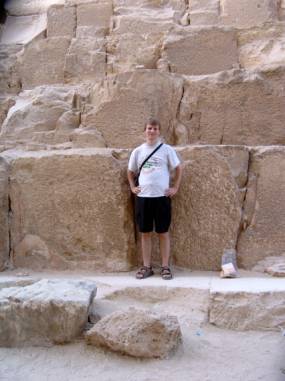
Den største af de tre, Kheops pyramide, er 146 meter høj,
920 meter i omkreds og består af 2,3 millioner stenblokke! Hver
blok var mindst en meter høj, så man kan forestille sig
hvor massive disse pyramider var.
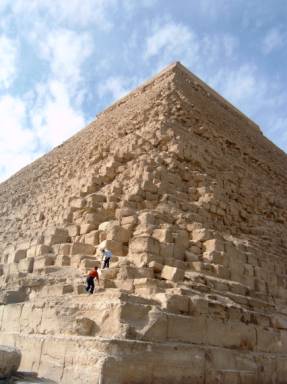
Den næststørste Khefrens (Kheops søn) pyramide har
stadig noget af de glatte skinnende kalkstens dækning, som engang
dækkede alle pyramiderne.==>
Den massive solbåd, som engang bragte
faraos krop fra Memphis til Giza og de tre mindre Dronninge pyramider
står ved foden af den massive Kheops pyramide. Vi havde ikke mulighed
for at komme ind i gravkammeret denne gang, men jeg føler mig
privilegeret over at jeg var derinde, og stadig har nogle minder fra
begivenheden.
|
Sphinxen
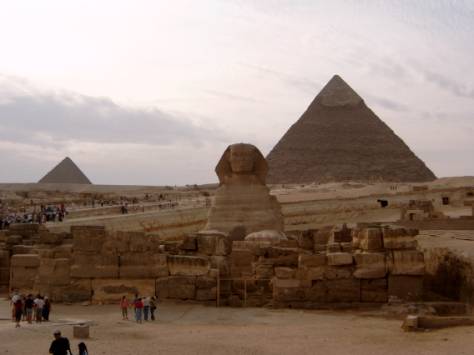 Pyramiderne
rejser sig i baggrunden, mens den sider stille på det varme sand
under den bagende sol i 4000 år. Napoleons tropper brugte den
som målskive, så næsen og faraos skæg er for
længst faldet af og findes i British museum. Grækerne kaldte
den "Sphinx", som var basseret på en mærkelig
skikkelse med hovedet af et menneske og kroppen af en løve, som
ville stoppe enhver rejsende langs vejen med en gåde - hvis gåden
ikke blev gættet, blev man måltid for Sphinxen. Trængslen
af skarerne omringede Sphinxen og vi kunne kun bevæge os i gåsegang.
Gennem tiden ser det ud til, at turisterne må se Sphinxen på
længere og længere afstand. For 50 år siden kunne
Bedstefar røre ved Sphinxen og også klatre op på
toppen af pyramiden; for 20 år siden var Sphinxen hegnet inde
med et lille trådhegn, men jeg kunne stå tæt ved den;
nu ligger den i et stort hul, hvor besøgende kun kan se den tæt
på gennem zoomen på deres kameraer. 4 tusind år senere
bjergtager den stadig os alle. Pyramiderne
rejser sig i baggrunden, mens den sider stille på det varme sand
under den bagende sol i 4000 år. Napoleons tropper brugte den
som målskive, så næsen og faraos skæg er for
længst faldet af og findes i British museum. Grækerne kaldte
den "Sphinx", som var basseret på en mærkelig
skikkelse med hovedet af et menneske og kroppen af en løve, som
ville stoppe enhver rejsende langs vejen med en gåde - hvis gåden
ikke blev gættet, blev man måltid for Sphinxen. Trængslen
af skarerne omringede Sphinxen og vi kunne kun bevæge os i gåsegang.
Gennem tiden ser det ud til, at turisterne må se Sphinxen på
længere og længere afstand. For 50 år siden kunne
Bedstefar røre ved Sphinxen og også klatre op på
toppen af pyramiden; for 20 år siden var Sphinxen hegnet inde
med et lille trådhegn, men jeg kunne stå tæt ved den;
nu ligger den i et stort hul, hvor besøgende kun kan se den tæt
på gennem zoomen på deres kameraer. 4 tusind år senere
bjergtager den stadig os alle.
|
Tirsdag 16. november 2004 (start 2:30)
Ja, du læste rigtig - vi ventede
alle I receptionen kl. 2.30. I aftes diskede Bedstemors børnebørn
op med Spansk-Ægyptisk-Italiensk middag til hele familien. Dette
fulgtes op af en 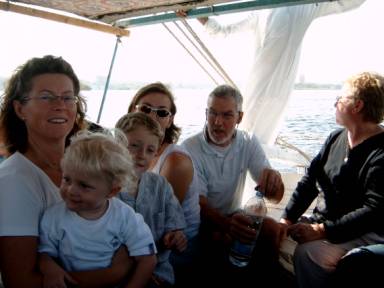 larm
fra tamboriner, obo og trommer, der spillede til forlovelsesfest for
et Ægyptisk par I receptionen. larm
fra tamboriner, obo og trommer, der spillede til forlovelsesfest for
et Ægyptisk par I receptionen.
Denne morgen fløj vi til Asuan for
at gå ombord til et Nilkryds på 4 dage op til Luxor. Da
vi ankom, tog vi på en "felucca" (nilbåd) tur
på Nilen med en fantastisk panorama til "Tomb of Nobles"
(de overordnedes grave). Da vi kom tilbage fik vi vores værelser
på en fire etages krydstogt skib, der havde motionsrum, svømmebassin
og soldæk øverst oppe. Selv fra vores værelser i
bunden, havde vi en fantastisk udsigt til de små moskelignende
bygninger på toppen af de store sandbjerge med små huler.
Om aftenen havde vi mulighed for at besøge
byens lille souq (locale bazaar), hvor de solgte t-shirts, papyrusbilleder,
dynger af safran og tørret vellugtende lotusblomster, brun, rød,
gul og indigo bjerge af duftende krydderier - alt noget som nogle af
os tingede om - det dyreste køb var 25£ for papyrus billede
og billigst 15£ for en broderet t-shirt med hieroglyffer. Sidst
brugte vi 5£ til en hestevogn tilbage til skibet. |
 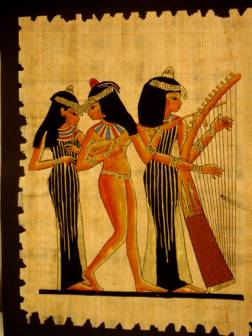
|
Onsdag 17. november 2004 (start 7:30)
Det ser ud til, at nogle I familien har
pådraget sig en maveonde. Vi andre undgik uvasket frugt, frisk
salat, rå grøntsager og drinks med vand fra vandhane. Dette
forhindrede os imidlertid ikke i at tage på sightseing.
Den ufærdige Obelisk
Hvis denne obelisk var blevet færdig,
ville det have været den højeste og tungeste nogensinde
fremstillet på 142 meter. Den ligger i et granitstenbrud, færdighugget
på tre sider, men opgivet da en revne viste sig i stenen. Det
er næsten umulig at forestille sig, hvordan de gamle ægyptere
kunne flytte selv en enkelt sten fra dette stenbrud, da dette sted er
ganske mange mile fra alle monumenterne, som er færdigfremstillet.
Uheldigt for Ægypten er de fleste obelisker blevet spredt til
andre lande - til Italien, England, Frankrig og selv Argentina - af
fremmede arkæologer gennem de sidste århundreder. Mange
af os havde ikke tid til at se hele obelisken før Adam ringede
med sin klokke, som han medbragte (for at genere os, tror jeg). |
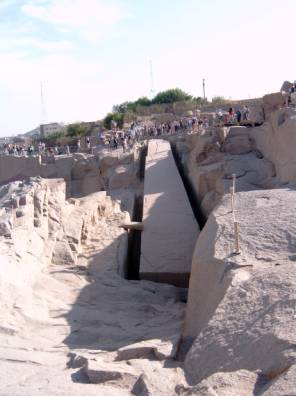 
|
Den Høje Dæmning
 I
århundreder har Nilen styret Ægypternes liv - hvad enten
der var oversvømmelse eller for lidt vand, var det skæbnesvangert
for folket, hvis liv afhang af denne store vandkilde. Da Asuandæmningen
blev bygget mistede nogle af landsbyerne i det sydlige deres vandforsyninger. I
århundreder har Nilen styret Ægypternes liv - hvad enten
der var oversvømmelse eller for lidt vand, var det skæbnesvangert
for folket, hvis liv afhang af denne store vandkilde. Da Asuandæmningen
blev bygget mistede nogle af landsbyerne i det sydlige deres vandforsyninger.
For 30 år siden blev den nye Høje
Dæmning bygget, hvilket resulterede i den menneskeskabte Nasser
sø mod syd. ==>
Det betød, at mange mennesker måtte
flyttes, da landsbyerne og bopladserne blev oversvømmet, ligesom
også nogle af de gamle Ægyptiske monumenter som Philae templet. |
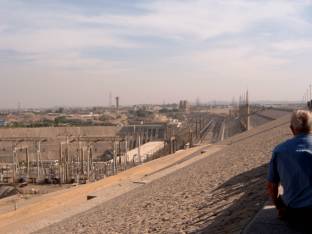 På
sit højeste er den Høje Dæmning 111 m, 3,8 km lang
og 980 m bred ved foden. På
sit højeste er den Høje Dæmning 111 m, 3,8 km lang
og 980 m bred ved foden.
Der er blevet brugt tre gange så
mange sten, som der var i Kheops pyramiden til bygningen af dæmningen.
Da dæmningen er militært område,
må man ikke bruge videokamera - hvis der blev rettet et angreb
på dæmningen kunne meget af Ægypten blive oversvømmet,
hvilket ville være en katastrofe for landet.
Efter kun 10 minutter "ringede"
Adam os tilbage til bussen igen.
|
Philae templet
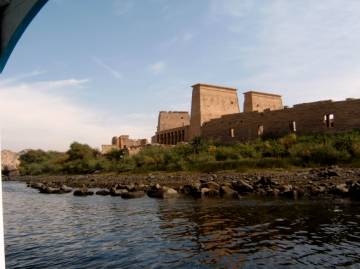 Efter
den første Asuan dæmning blev bygget, var Philae templet
oversvømmet 6 måneder om året, og turisterne måtte
se templet gennem Philae søens mudrede vand. Da den Høje
Dæmning blev bygget, truede det med at oversvømme templet
for evigt. Templet blev da flyttet sten for sten til en ø med
et lignende landskab. Philae er speciel i, at den kun kan nås
med båd og at solnedgangen giver et spektakulært bagtæppe.
Templet, som er bygget til Isis (gudinden for kvinder, sexualitet og
renhed), var en af de sidste hedenske udsteder og på grund af
Isis popularitet, blev det også brugt af de tidlige Kristne. Templets
vægge og mange af søjlerne var fra top til fod fyldt med
hieroglyffer og billeder af Isis - mange af billedernes ansigter var
ødelagt af de tidlige Kristne, som anså de gamle Ægyptiske
guder for hedenske. Jeg havde en fantastisk eftermiddag med at vandre
ind og ud af gennem alle krogene og sprækkerne - besøge
Fødselshuset, Nilometeret, Faraos sengested og meget mere og
til stor morskab for familien, var jeg den sidste til at møde
op. Efter
den første Asuan dæmning blev bygget, var Philae templet
oversvømmet 6 måneder om året, og turisterne måtte
se templet gennem Philae søens mudrede vand. Da den Høje
Dæmning blev bygget, truede det med at oversvømme templet
for evigt. Templet blev da flyttet sten for sten til en ø med
et lignende landskab. Philae er speciel i, at den kun kan nås
med båd og at solnedgangen giver et spektakulært bagtæppe.
Templet, som er bygget til Isis (gudinden for kvinder, sexualitet og
renhed), var en af de sidste hedenske udsteder og på grund af
Isis popularitet, blev det også brugt af de tidlige Kristne. Templets
vægge og mange af søjlerne var fra top til fod fyldt med
hieroglyffer og billeder af Isis - mange af billedernes ansigter var
ødelagt af de tidlige Kristne, som anså de gamle Ægyptiske
guder for hedenske. Jeg havde en fantastisk eftermiddag med at vandre
ind og ud af gennem alle krogene og sprækkerne - besøge
Fødselshuset, Nilometeret, Faraos sengested og meget mere og
til stor morskab for familien, var jeg den sidste til at møde
op.
|
 Kom
Ombo Kom
Ombo
Skibet sejlede fra Asuan kl. 15.45 efter
en eftermiddag tilbragt med solbadning og øldrikning (typisk
dansk med solbadning og øl). Vi sejlede 48 km. nord for Asuan
til Kom Ombo - den gamle by med tilbedelsen af krokodilleguden Sobek.
Den gamle by er for længst forsvunden og krokodillernes eksistens
på de nærliggende sandbanker er blevet jagtet til udryddelse.
I solnedgangen besøgte vi Kom Ombo
templet, opført til både krokodilleguden Sobek og Horus,
den falkehovede himmelgud og Isis søn. Selvom vi ikke havde tiden
til at fordybe os i 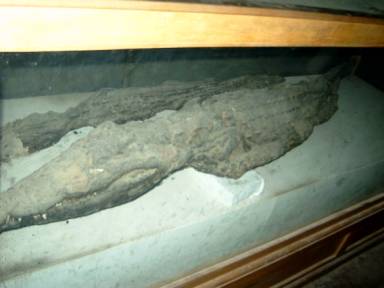 dette
tempen, var det både imponerende og sælsomt med store projektører,
der belyste templet. Der var en brønd med vand og en afsats halvvejs
nede, hvor krokodiller gennem en gang blev lokket ind fra Nilen med
menneskekød, og den største krokodille blev fanget og
mumificeret som et offer til Sobek. Ved kapellet for Hathor (Horus hustru)
var der en Amerikaner, der udbrød "Gud, jeg troede jeg skulle
se krokodillestatuer!" - latter - Kapellet indeholdt to krokodillemumier
fundet i templet. dette
tempen, var det både imponerende og sælsomt med store projektører,
der belyste templet. Der var en brønd med vand og en afsats halvvejs
nede, hvor krokodiller gennem en gang blev lokket ind fra Nilen med
menneskekød, og den største krokodille blev fanget og
mumificeret som et offer til Sobek. Ved kapellet for Hathor (Horus hustru)
var der en Amerikaner, der udbrød "Gud, jeg troede jeg skulle
se krokodillestatuer!" - latter - Kapellet indeholdt to krokodillemumier
fundet i templet.
Vi returnerede til et lille cocktail party
før middagen, givet af skibet for at introducere de ansvarlige
for personalet og for at gøre vores tur behagelig.
|
Tirsdag 18. november 2004 (start 7.00)
Gennem natten sejlede vi fra Kom Ombo til
Edfu, et lille regionalt center for sukkerrørshandlen, besøgte
Horus templet og sejlede videre til broen over Nilen og slusesystemet
ved Esna.
Horus templet
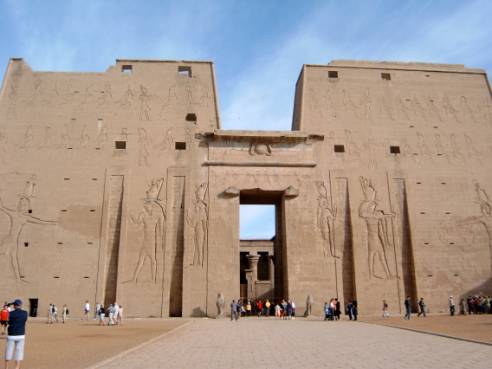 Dette
er det mest komplette %2f2018%2f01%2f_DSC8122.jpg.axdx"> Dette
er det mest komplette %2f2018%2f01%2f_DSC8122.jpg.axdx">
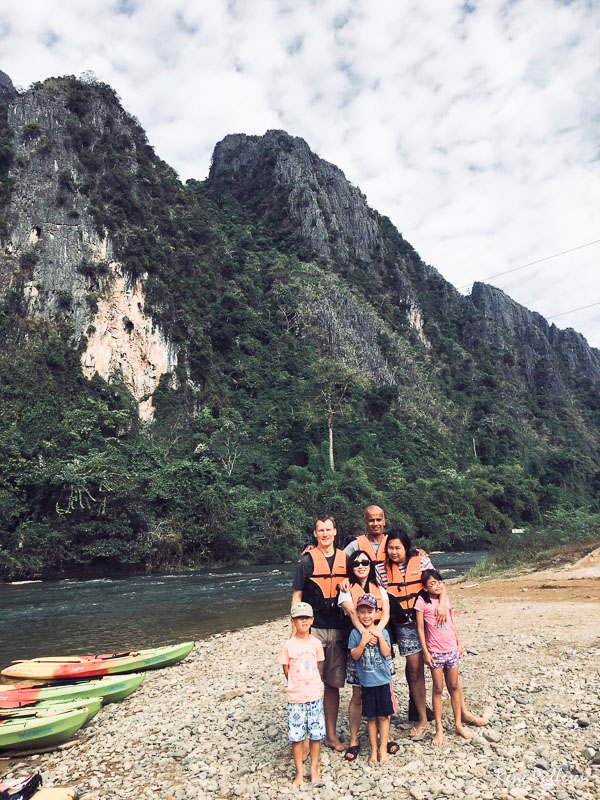
Another water activity that Mavis and I did was tubing through one of the caves. You essentially sit in an inflated car tyre and then pull yourself along a rope inside a cave. It was fun for the kids, however this place was packed with Koreans trying to do the same thing.
Aiden initially didn't want to go, but I am proud that he eventually managed to get the courage to do so.
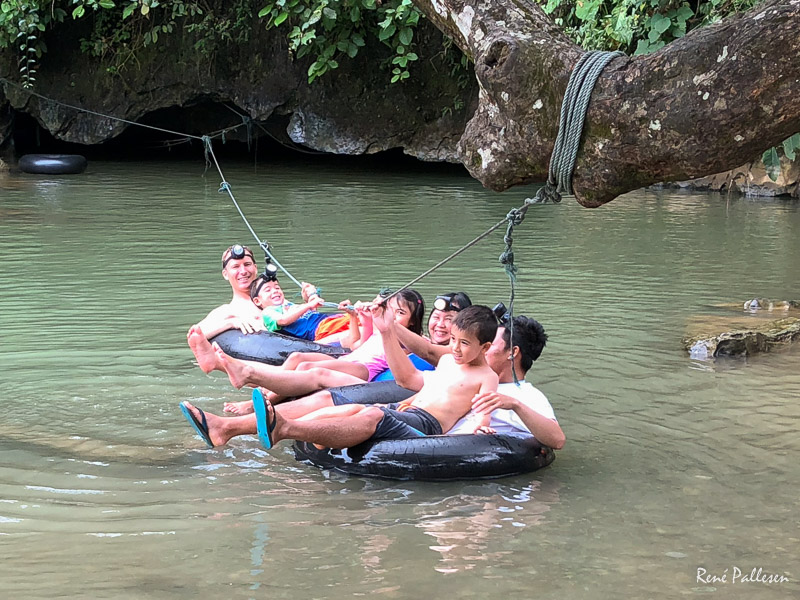
We also went to one of the lagoons. There are a number of them and some of them are very popular. We organised with a driver to drive us to one of the less popular ones. It was still scenic and it had platforms of the trees to jump from and you could see why some travelers would have killed themselves jumping off them.
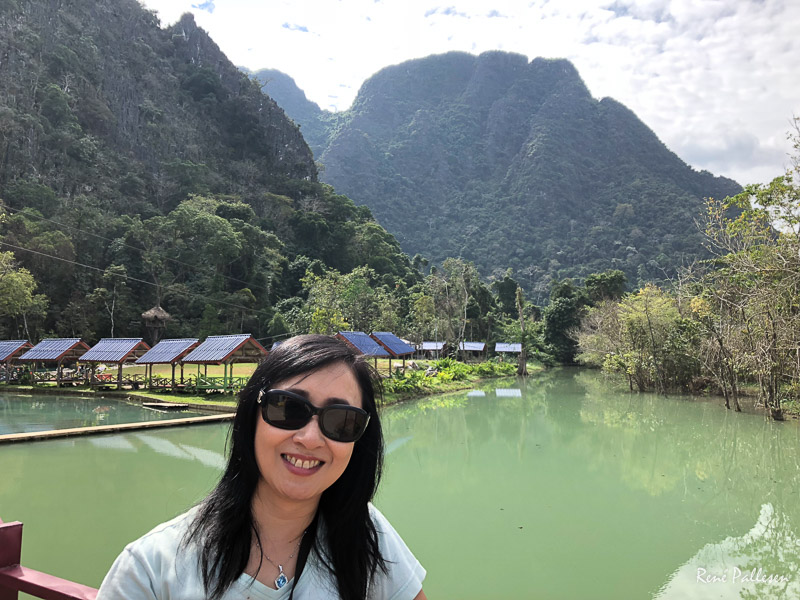
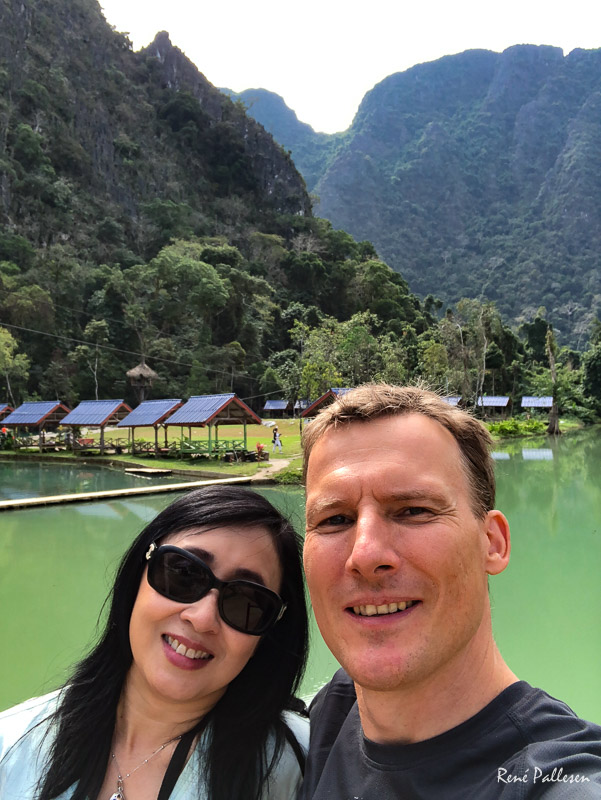
There were also a couple of rafts which reminded me of the first time I went to Laos and paddles across a local river on a raft. It got on one of them in the lagoon and the whole thing literally sunk under me - I only just managed to get off in time before getting soaked.
The second one was able to hold my weight and I took the boys for a little paddle.
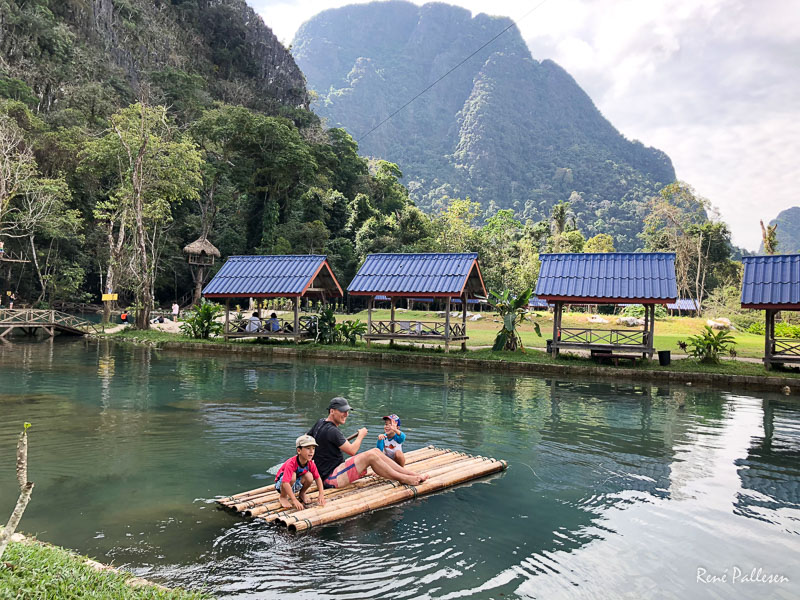
9. January 2018 19:01
by Rene Pallesen
0 Comments
At one of the caves in Laos there is this amazing Buddha statue inside the cave. I couldn't help but notice how beautiful the diffused light was falling onto the statue itself and through the entrance to the cave. We were there all by ourselves and I asked Kim to sit and offer a little prayer in the ray of light coming in through the cave. I didn't bring a tripod with me to Laos, so everything had to be shot handheld which was tricky as there wasn't much light there. 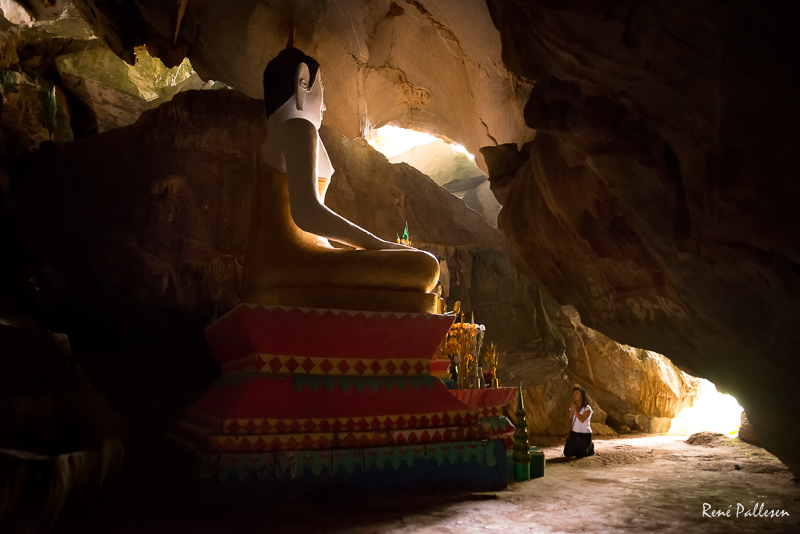
8. January 2018 18:01
by Rene Pallesen
0 Comments
7. January 2018 21:01
by Rene Pallesen
0 Comments
6. January 2018 20:01
by Rene Pallesen
0 Comments
On the first day in Vang Vieng we hired a local guide to take us through the country side and some of the villages around Vang Vieng. 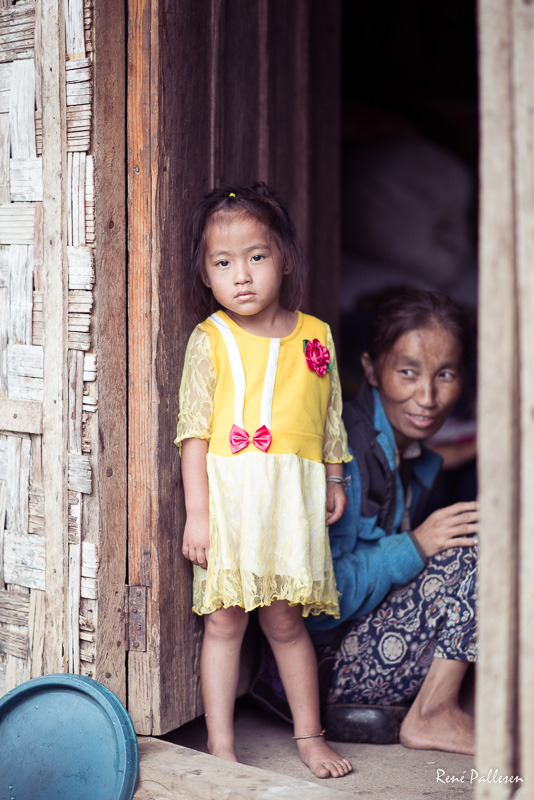 Hiking through the countryside in Laos is partly magical and at the same time an eye opener. It is not until you get into the country side that you get a glimse of the real Laos and its people, the way of living and their beliefs. Walking into the first village a group of boys came walking towards us. One of the kids was holding his head with blood dripping down his face. The other boys were taking him home to his parents. I couldn't help but notice that there was a green substance smeared across the wound and asked our guide is he knew what it was. He went over to some bushes and plucked a couple of leaves and said that if you crush them then they will help stop the bleeding. This is when you realise that a lot of the plants in the villages serve a purpose as natural herbal medicine or for eating. The village was a HMong village and at one of the houses we spotted the little girl above standing in a door opening with her grand mother. There are very few of the traditional bamboo shacks still standing and instead being replaced with brick buildings. 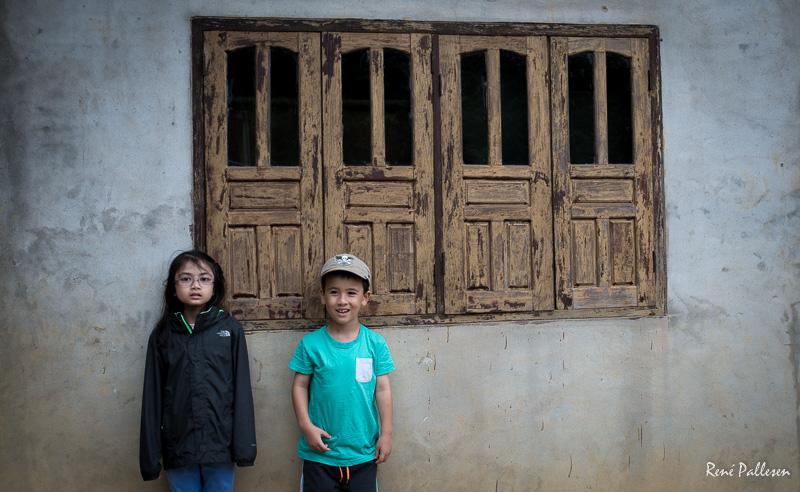 A bit further up the road we heard a sound. Someone was hitting a gong and chanting. Thinking it might be a monk we went to investigate. The sound was coming from one of the local houses. At the back of the house the family was in the process of preparing food, but we couldn't see where the sound was coming from. Our guide asked them and was told that they had a newborn (possibly sick) child and that the Shaman was in the house talking to the 'other world to' attract the good spirits and chase the evil spirits away. 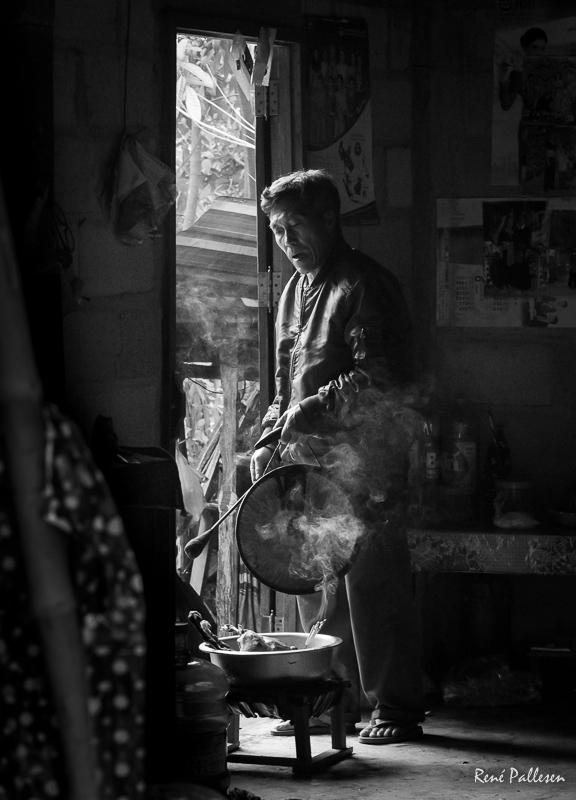 As we walked on we could see him through the opening of the door and I snapped the above photo which is one of my favourite photos of the trip. In the village people go about their normal life such as this woman removing lice from her daughters hair.  As we walked on we had to walk through the local school. It happened to be recess and the kids in the smaller classes were outside playing. 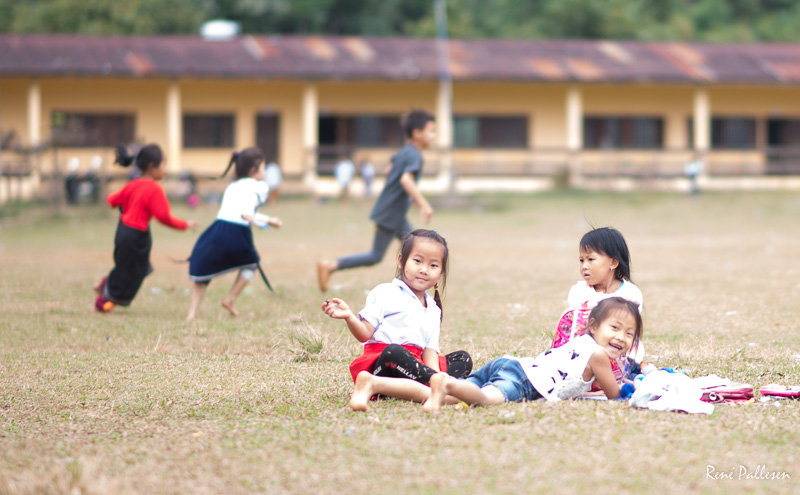 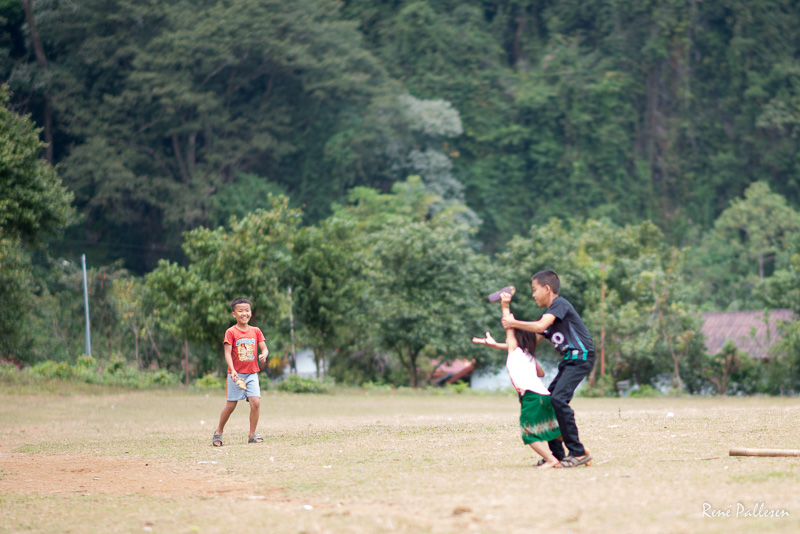 There was a small stand selling them lunches who also sold lollies, so Kim got the idea to spoil the kids with lollies - but also turned out to be a great opportunity for our kids to interact and see what a classroom in Laos looks like.  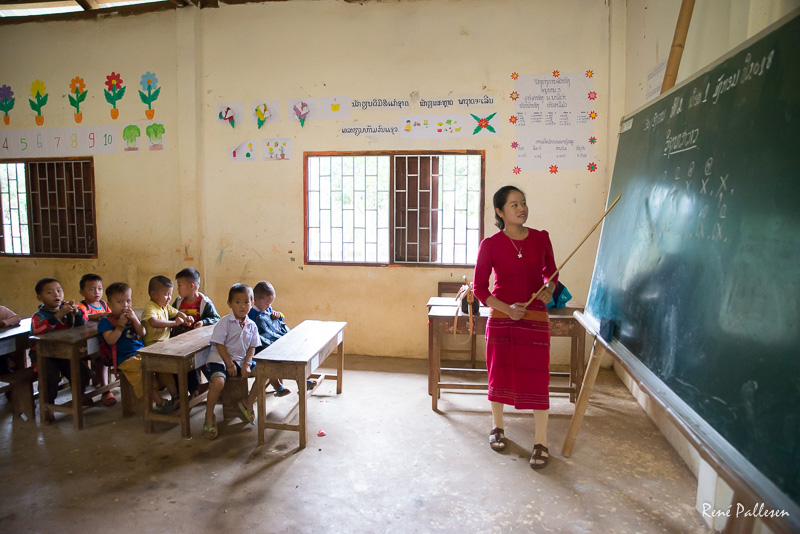 The area is still very un-developed. Although there seems to be electricity, this is mainly used for lighting. Cooking is still done by collecting wood and done on wood fired stoves and people still wash their clothes in the rivers and streams. 
på toppen af bakkerne omkring templet. Templet var tidligere begravet
helt op til taget med en landsby opført ovenpå. Mange af
templets relieffer viser den voldsomme kamp mellem Horus og hans bror
Seth.Vi gik ned i et lille Nilometer - en mørk, snæver
tunnel, der stank af urin, som engang blev brugt til at måle Nilens
vandstand. Igen var jeg den sidste (kun et par minutter for sent) til
store klapsalver fra alle (og et stikkende blik fra Adam).<br><br></td></tr><tr><td><br><br><img src=) Tilbage
på skibet til afgang kl. 9.00, hvor vi afsejler mod Esna, 48 km
syd for Luxor. Mens familien trængte sig sammen på soldækket,
sad jeg i solen på skibets fordæk i fred og ro. Det var
rigtig skønt at sidde på et skib - ikke for lille eller
for stor - og skue det skiftende sceneri på begge bredder, store
palmelunde og frodige grønne marker passerede forbi, et rygende
flimmer, skibet, der bevæger sig med fredfyldte 16 km/t og passerer
utrolige bjerge af sand og sten. Ole gør mig selskab for en snak
- han og Irene flytter til Grønland på tirsdag. Senere
på formiddagen sluttede jeg mig til René og Ulla ved poolen,
der sludrede om Bedstefar og familie sammenligningerne, mens de betragtede
Vinnies børn og Sebastian plaske rundt i pølen, og Lonnie,
Sarah og Berit afklædt til et minimum for at få lidt farve. |
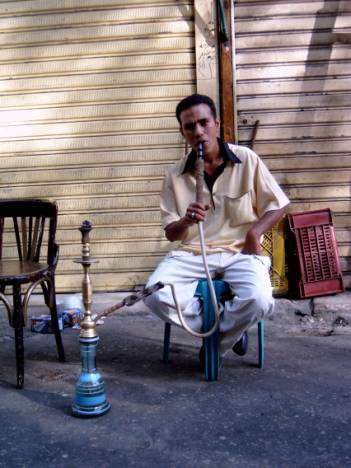 Vi
ankom til Esna og brugte et par timer til at strække benene efter
en formiddag at have dovnet omkring pølen. Jeg kløede
efter at spadsere i Esna, væk fra turister og se, hvordan de lokale
boede. René og jeg gik efter de stille gader og undgik de travle
gader omkring souqen. Vi blev fulgt af en flok børn i lange grå
eller hvide klæder, der førte og irriterede os. De fleste
af de snævre gader var ubelagte, nogle var mudrede og lugtede
af gødning. Magre, skelletagtige æsler stod forspændt
arbejdsvogne, mange sky piger vinkede fra deres mørke døråbninger
eller fra 1.sals vinduer, mens små drenge kom ud for at sige hello
og kredse omkring os. De fleste huse var simple af lermursten og med
små tilskoddede vinduer for at holde varmen ude.Nogle havde fantastiske
udskårne trædøre, efterladenskaber fra kolonitiden.
Tilfældige blikke ind gennem døråbningerne afslørede
tomme mudderklinede rum, da de fleste mennesker boede på første
sal. Ind imellem råbte René "imshee!" (forsvind),
når børnene blev for støjende og nærgående,
trak os i armene og smed småsten efter os. Da jeg snublede over
en pibende sort og hvid sygelig hvalp svøbt i brun papir, som
var sparket til side - rakte jeg næsten ud efter den, hvis ikke
René havde stoppet mig. Det var klogt endog ikke at komme i kontakt
med børnene, som var støvede og klædt i de lange
Ægyptiske dragter. Det var en befrielse, da de til sidst forlod
os, selv om vi vidste de gemte sig i smøgene og iagttog os skride
gennem gaderne. Der var guldsmedier glimrende af smykke ringe, øreringe
og halskæder; skræddere, der stadig syede i hånden
sidende på trappetrinene til deres butikker; kaffehuse fyldt kun
med mænd, der røg på deres vandpiber - deres øjne
fulgte os ned ad gaden. Vi havde siddet forskellige steder så
lang tid, at det var godt at komme væk. Vi
ankom til Esna og brugte et par timer til at strække benene efter
en formiddag at have dovnet omkring pølen. Jeg kløede
efter at spadsere i Esna, væk fra turister og se, hvordan de lokale
boede. René og jeg gik efter de stille gader og undgik de travle
gader omkring souqen. Vi blev fulgt af en flok børn i lange grå
eller hvide klæder, der førte og irriterede os. De fleste
af de snævre gader var ubelagte, nogle var mudrede og lugtede
af gødning. Magre, skelletagtige æsler stod forspændt
arbejdsvogne, mange sky piger vinkede fra deres mørke døråbninger
eller fra 1.sals vinduer, mens små drenge kom ud for at sige hello
og kredse omkring os. De fleste huse var simple af lermursten og med
små tilskoddede vinduer for at holde varmen ude.Nogle havde fantastiske
udskårne trædøre, efterladenskaber fra kolonitiden.
Tilfældige blikke ind gennem døråbningerne afslørede
tomme mudderklinede rum, da de fleste mennesker boede på første
sal. Ind imellem råbte René "imshee!" (forsvind),
når børnene blev for støjende og nærgående,
trak os i armene og smed småsten efter os. Da jeg snublede over
en pibende sort og hvid sygelig hvalp svøbt i brun papir, som
var sparket til side - rakte jeg næsten ud efter den, hvis ikke
René havde stoppet mig. Det var klogt endog ikke at komme i kontakt
med børnene, som var støvede og klædt i de lange
Ægyptiske dragter. Det var en befrielse, da de til sidst forlod
os, selv om vi vidste de gemte sig i smøgene og iagttog os skride
gennem gaderne. Der var guldsmedier glimrende af smykke ringe, øreringe
og halskæder; skræddere, der stadig syede i hånden
sidende på trappetrinene til deres butikker; kaffehuse fyldt kun
med mænd, der røg på deres vandpiber - deres øjne
fulgte os ned ad gaden. Vi havde siddet forskellige steder så
lang tid, at det var godt at komme væk.
Gennem slusen
Vi
sejlede kl. 15.00 og samledes med andre skibe som vores ved en bro lige
nord for Esna. Hver fjerde time åbner broen i en time for skibene
og bilerne kunne i stedet tage en lille færge over Nilen. Til
aften har skibet dækket op til en speciel Ægyptisk "Orientalsk"
middag, hvor gæsterne kunne klæde sig i ægyptiske
dragter. Det var et festmåltid med fladbrød, baba ghanoush,
varme fyldte zucchini og peberfrugt, varme pølseruller, kikærter,
linser, fisk, traditionel ret af okra (ligner grøn chili, men
er ikke stærk), pyntet og risfyldt hel lam med foliedækket
hoved med små magre oberginer som ører sat op på
et sølvfad. Som afslutning på det hele var der et bord
med ægyptiske desserter - semulje tærte, mandel-mælk
agar (gelé) og små tærter med honningsmag. Mellem
22 0g 23 samledes vi alle for at se slusningen.
Ved
slusning føres skibet fra et niveau til et andet niveau, som
regel ved en dæmning. To krydstogtskibe sejlede ind i slusen,
hvorefter portene lukkedes efter os. Vandet ledtes ud af slusen og skibene
blev sænket næsten 10 meter ned, hvorefter portene foran
skibene åbnedes, og vi sejlede videre. Slusningen tog ca. en time,
selv om ventetiden varede nogle timer for at komme til. Det var værd
at se, selv om vi skulle starte tidlig næste morgen. Det mest
fantastiske var at se den ekspertise skibet førtes gennem den
snævre sluse med næsten ingen plads til begge sider.
|
Fredag 19 November 2004 (start 7.00)
Gennem natten sejlede vi fra Esna til Luxor,
vores sidste havn, hvortil vi kom ca. kl. 2. Vi blev effektivt vækket
og kunne høre telefonvækningen omkring på de værelser,
som skulle ud på en tidlig tur. Vi havde en lang dag for os, hvor
vi skulle besøge fire steder.
Kongernes dal
Bygmestrene af de store pyramider opdagede,
at skjulte indgange og falske skakter ikke beskyttede deres døde
faraoer eller rigdommene, der var med i gravene, for gravrøvere,
så fra det 18. dynasti startede de gamle ægyptere med at
grave i undergrunden. Rullende bakker og dale af sand, grus og solid
sandsten - det er forbavsende at tænke sig, at de gamle Ægyptere
var i stand til at begrave over 300 faraoer hvoraf kun 62 er fundet
(den sidste var TutAnkhAmun). |
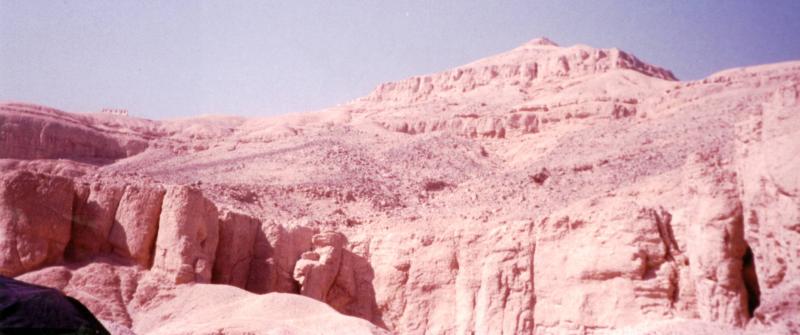 Bjerget, under hvilket mange af gravene er fundet,
har en pyramidelignende fason. |
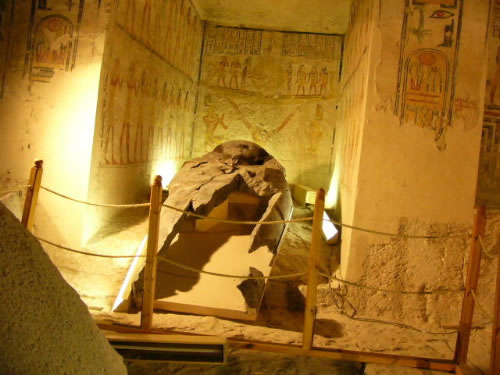
Vores billetter gav os ret til kun at besøge tre grave og kun
en håndfuld var åbne på dagen med lange køer
ved alle.
Vi besøgte gravene for Ramsesene
III, IX og V/VI - alle relative små grave, nogle delvis udgravede,
andre meget skadede af fugtighed fra de mange turister og fra svedige
fingre.
|
 Der
var en mængde af hieroglyffer og billeder af faroerne, hvordan
de behandlede deres undersåtter, selv lofterne var smukt udsmykket
med blå himmel, tusinder af stjerner og himmel gudindens hoved.
Ramses III´s grav var som en billedbog over "Bedre Huse og
Haver" med billeder af hundrede af krukker, møbler og madkunst.
I Ramses V/VI's grav var der en kæmpe revnet Faraoformet sarkofag
uhyggelig illumineret med sølvagtig lys - Ramses VI delte usædvanligt
graven med sin forgænger og broder. Det er rugtig forbavsende,
at sådanne billeder har overlevet tusinder af år, gemt bort
i mørke tørre grave, som hurtig nedbrydes, efter at de
er blevet udgravet. Der
var en mængde af hieroglyffer og billeder af faroerne, hvordan
de behandlede deres undersåtter, selv lofterne var smukt udsmykket
med blå himmel, tusinder af stjerner og himmel gudindens hoved.
Ramses III´s grav var som en billedbog over "Bedre Huse og
Haver" med billeder af hundrede af krukker, møbler og madkunst.
I Ramses V/VI's grav var der en kæmpe revnet Faraoformet sarkofag
uhyggelig illumineret med sølvagtig lys - Ramses VI delte usædvanligt
graven med sin forgænger og broder. Det er rugtig forbavsende,
at sådanne billeder har overlevet tusinder af år, gemt bort
i mørke tørre grave, som hurtig nedbrydes, efter at de
er blevet udgravet.
|
Memnon kolosserne
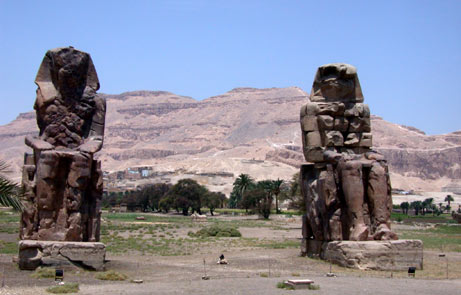 Lige
efter Kongernes Dal stoppede vi for at se Memnon kolosserne - to 18
meter høje figurer af Amenhotep III, som stod foran hvad men
mener var Ægyptens største tempel, endnu større
end det eksisterende Karnak tempel. Hver af statuerne er hugget ud af
en hel sten, engang berømte for klokkelignende toner, der opstod
fra statuerne ved solopgang. Grækerne troede disse lyde blev lavet
af den udødelige Memnon, der hilste på sin moder. Efter
at en Romersk hersker foretog restaurationer på kolosserne i 170
efter kristus, forsvandt lydene. Lige
efter Kongernes Dal stoppede vi for at se Memnon kolosserne - to 18
meter høje figurer af Amenhotep III, som stod foran hvad men
mener var Ægyptens største tempel, endnu større
end det eksisterende Karnak tempel. Hver af statuerne er hugget ud af
en hel sten, engang berømte for klokkelignende toner, der opstod
fra statuerne ved solopgang. Grækerne troede disse lyde blev lavet
af den udødelige Memnon, der hilste på sin moder. Efter
at en Romersk hersker foretog restaurationer på kolosserne i 170
efter kristus, forsvandt lydene.
Til vores morskab gjorde Adam endnu et
"kommisions stop" ved en alabaster butik. Han kunne ikke forstå,
hvorfor vi brød ud i latter. I stedet for at boycotte turen,
skyndte vi os alle ind for at få en kop gratis myntete (som ikke
havde noget med myntete at gøre). René førte an
i et race med Sebastian og Vinnies drenge med det glatte alabastergulv
som glidebane. I den anden ende blev Ulla præsenteret for en lille
10000£ alabaster flodhest, som hun i sjov sagde ja til, hvorefter
butiksassistenten gik for at sætte den til side.
|
Hatshepsut templet
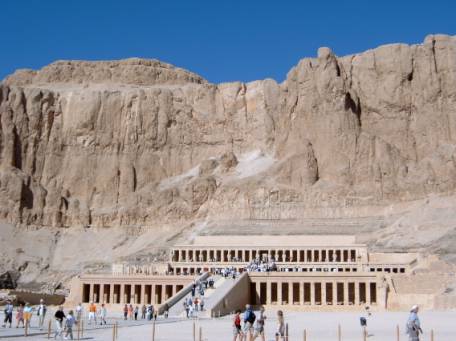 I
nærheden af Kongernes Dal ligger dette tempel for den eneste kvindelige
Farao, der har regeret Ægypten. På grund af et forkvaklet
arbejde af et rent Ægyptisk arkæologisk hold, blev templets
ruiner genrejst til at indeholde et busdepot, resulterende i at meget
af de originale kunstværker blev overmalet eller ødelagt.
Efterfølgeren til Hatshepsuts bror/mand var stedsønnen
Tuthmose III, som måtte vente 20 år på sin trone,
hvorfor Hatshepsut ikke blev balsameret, da hun døde, og hendes
tempel blev ødelagt som straf. Templet stod på stedet for
et Koptisk kloster og fantastiske sandstensklipper. Der er måske
ikke meget af templet at se, men synet tæt på, fra stor
afstand og endog fra himlen gør absolut turen værd. I
nærheden af Kongernes Dal ligger dette tempel for den eneste kvindelige
Farao, der har regeret Ægypten. På grund af et forkvaklet
arbejde af et rent Ægyptisk arkæologisk hold, blev templets
ruiner genrejst til at indeholde et busdepot, resulterende i at meget
af de originale kunstværker blev overmalet eller ødelagt.
Efterfølgeren til Hatshepsuts bror/mand var stedsønnen
Tuthmose III, som måtte vente 20 år på sin trone,
hvorfor Hatshepsut ikke blev balsameret, da hun døde, og hendes
tempel blev ødelagt som straf. Templet stod på stedet for
et Koptisk kloster og fantastiske sandstensklipper. Der er måske
ikke meget af templet at se, men synet tæt på, fra stor
afstand og endog fra himlen gør absolut turen værd.
Så fik vi frokost og et lille hvil.
Jeg blev overrasket over, at et humoristisk medlem af rengøringspersonalet
havde sat håndklæder, tæppe og pude op i min seng,
så det lignede en mand og hans slange. Jeg troede René
havde lavet grin med mig, til jeg fandt ud af, at noget lignende var
lavet i andre familiemedlemmers værelser!
|
 Karnak
Luxor templer Karnak
Luxor templer
Karnak var kendt som "Ipet-Isyt"
- det mest perfekte af stederne.
Meget af det ligger I ruiner, men er muligvis
det største tempelkompleks bygget nogensinde og skabt over 1500
år af efterfølgende generationer af Faraoer.
Det var boplads for Faroer, stedet for
gudedyrkelse, rigt skattekammer og administrationscenter med tusinder
ansat.
Karnak er berømt for dets gigantiske
søjler - 134 på 15 meters højde, 12 i midten på
21 meter. Der skal seks voksne til at favne omkring en søjle.
Engang stod der statuer af Faraoer mellem
søjlerne og hele stemningen ville have været skræmmende,
som at passere gennem en hal af kæmpe guder. |

<== Ramses II var ansvarlig for meget
af restaureringen af templet, og hans signatur er hugget dybt ind i
flere områder, så ingen anden Farao kunne tage ærebookShare" src="http://static.ak.fbcdn.net/connect.php/js/FB.Share" type="text/javascript">A must see in Vientiane is Pha That Luang - It is on every bank note in Laos and they are very proud of it.

Unlike Buddha Park it is surprisingly quiet when it comes to tourists. The majority of people visiting seems to be either Laos or Thai people offering a prayer. The correct way here is to get the insense and flowers and then walk clockwise around the Stuba on the inside of the covered corridor (mostly to keep out of the sun I assume).
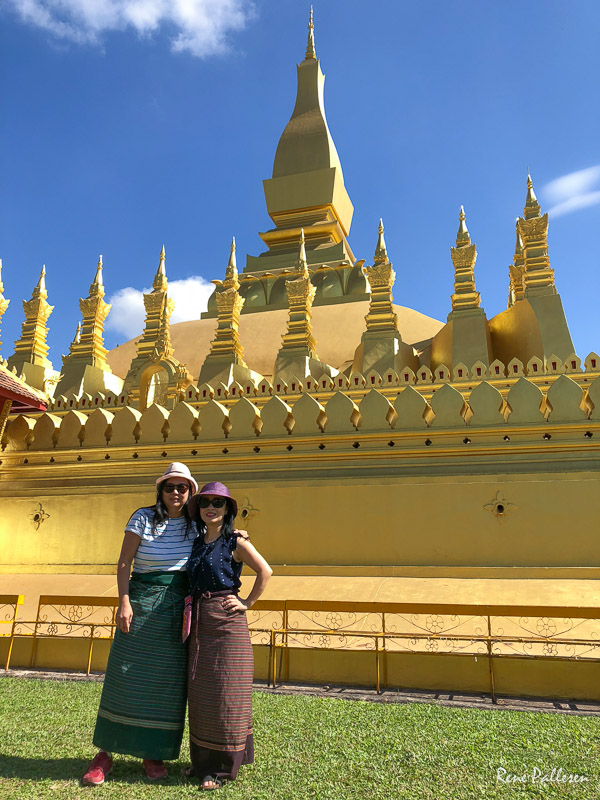
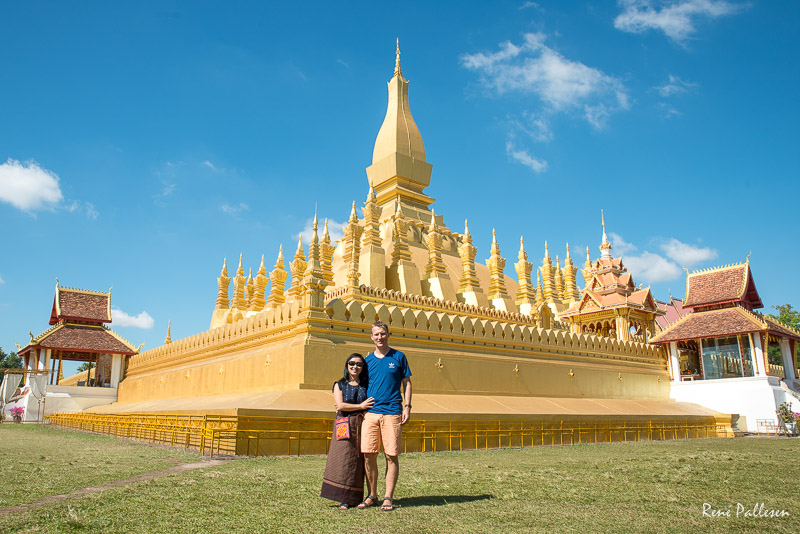
Although it is not particularly old (The original 1st century structure was mostly destroyed and has undergone a number of more recent restorations), it is stunningly beautiful and impressive in size.
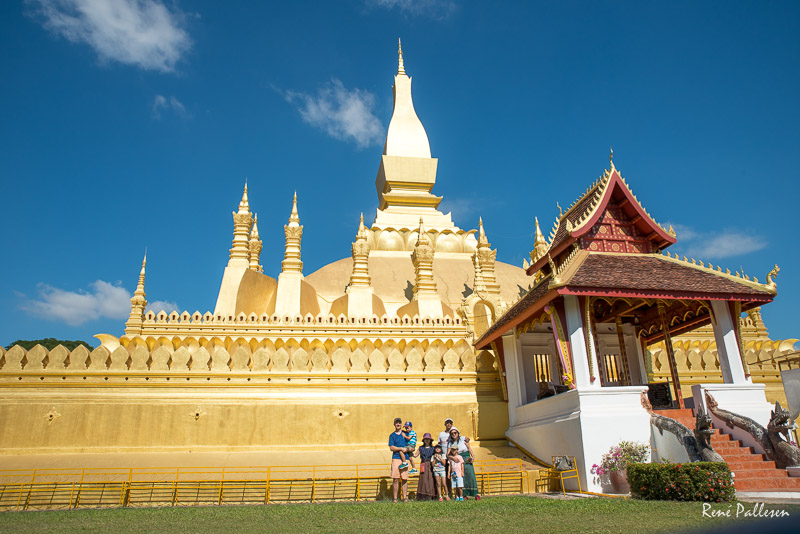
For me to get some of the panorama photos here with the selection of lenses I'd brought along I had to take multiple photos that I then had to stitch together.
Outside there is a temple that is equally interesting, although nothing compared to further north in Luang Prabang.
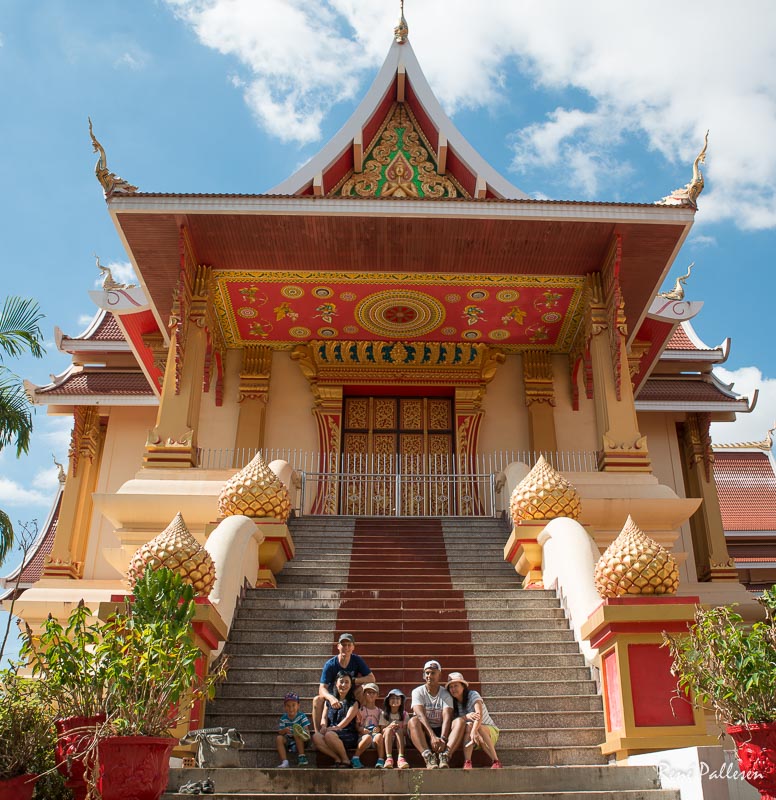
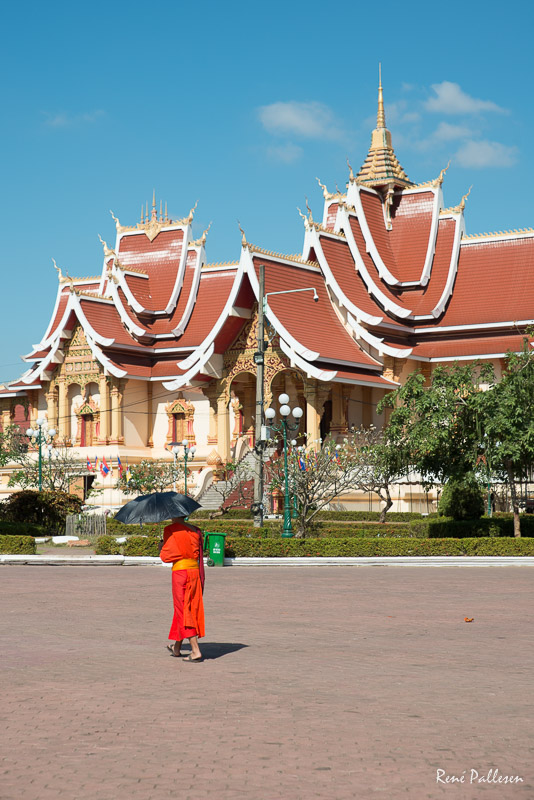
There are also street vendors selling cage birds that are supposed to bring good luck and prayers to anyone releasing them.
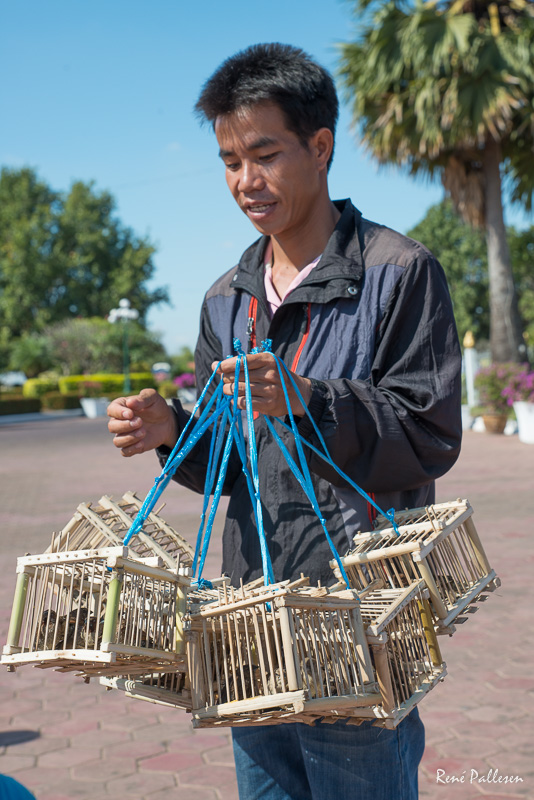
2. January 2018 10:01
by Rene Pallesen
0 Comments
One of the sights we wanted to visit was Buddha Park outside Vientiane (close to the border crossing back into Thailand). 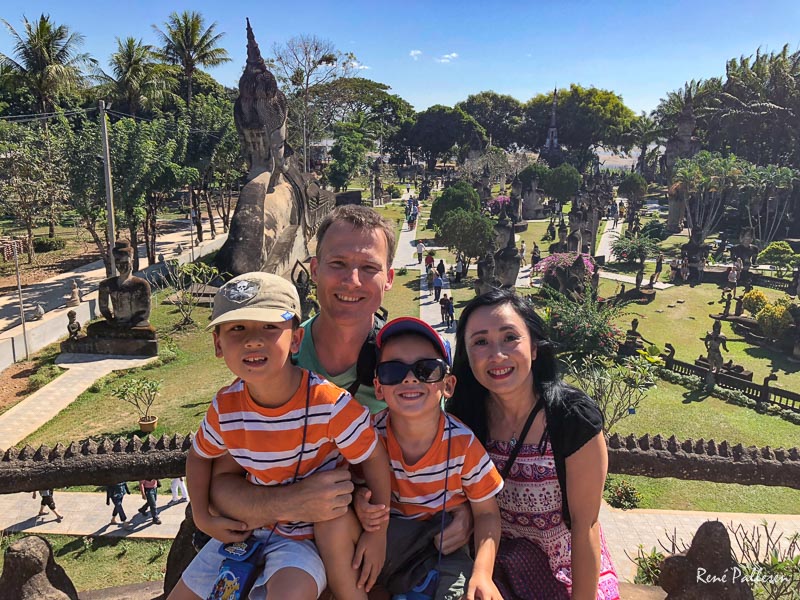 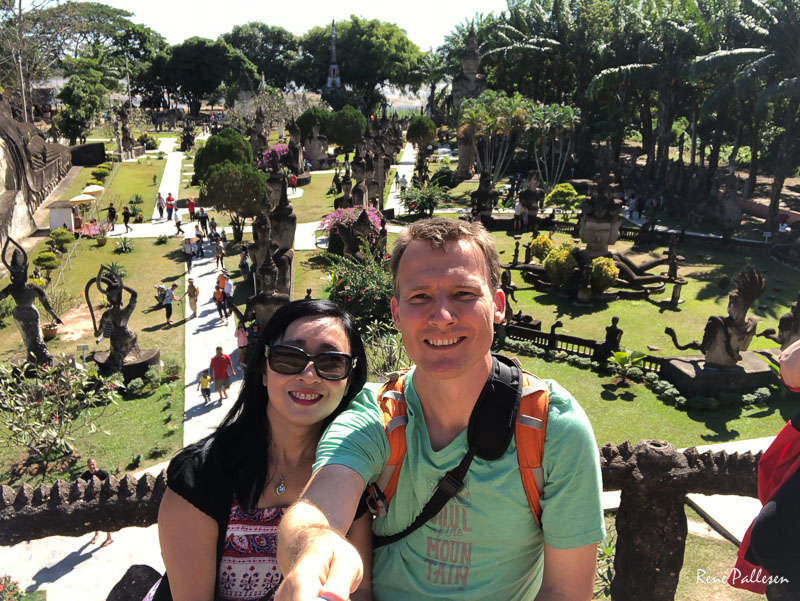 Trying to figure out the most comfortable way to get there we settled on taking the local bus. There aren't any taxis as such in Vientiane and we weren't keen taking a tuk-tuk for 30 kilometers. Most of the tuk-tuks are in an extremely poor shape with failing brakes, wobbling wheels and thick smoke coming out of the exhaust pipes. They are perfectly fine for shorter trips inside the city (such as hotel to bus station), but not recommended for longer trips. The bus turned out to be easy to find and we were early enough to all get a seat. The bus was later packed with passengers going to Thailand and it would have been tough to stand up for the one hour bus ride. The bus is also really convenient in that it stops right outside Buddha Park which is the last stop before the bus turns around and heads back to Vientiane. 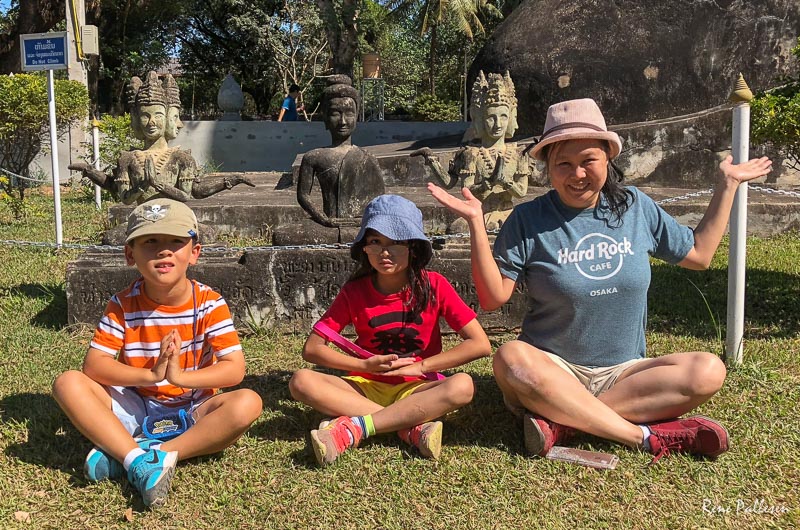 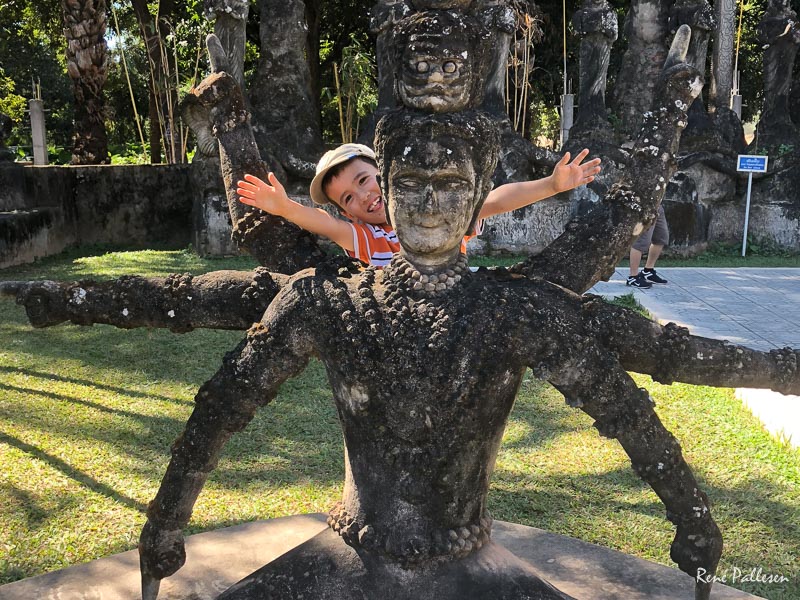 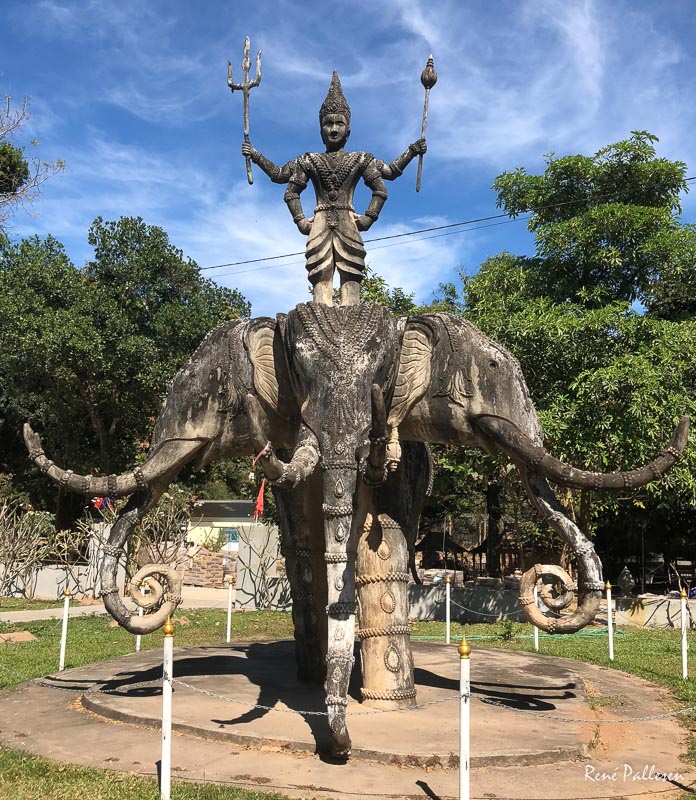 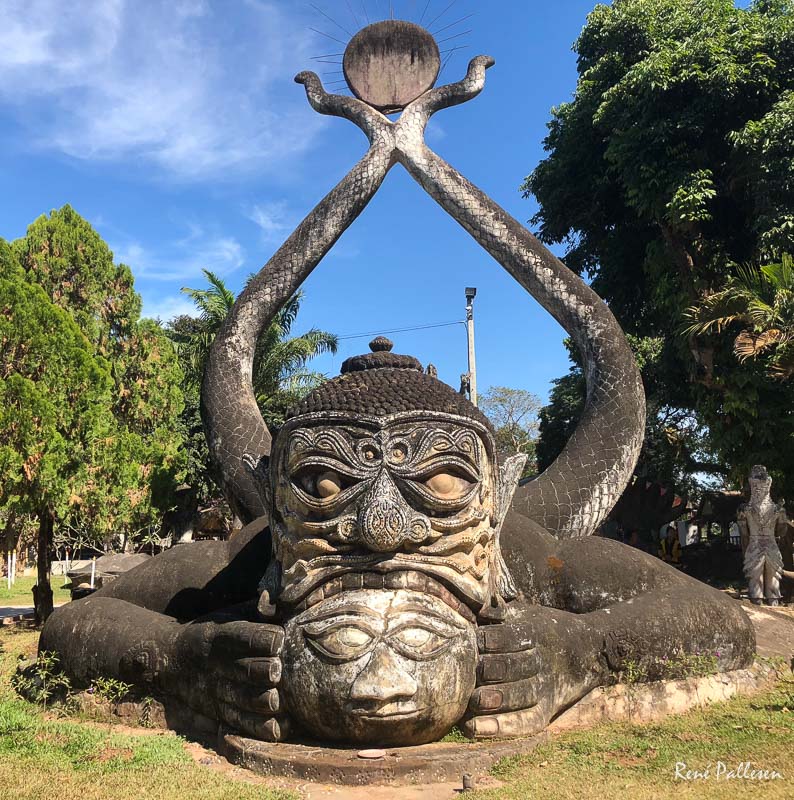 Buddha Park itself was apparently established by a Monk building the statues for religious purposes as education of his religious beliefs. 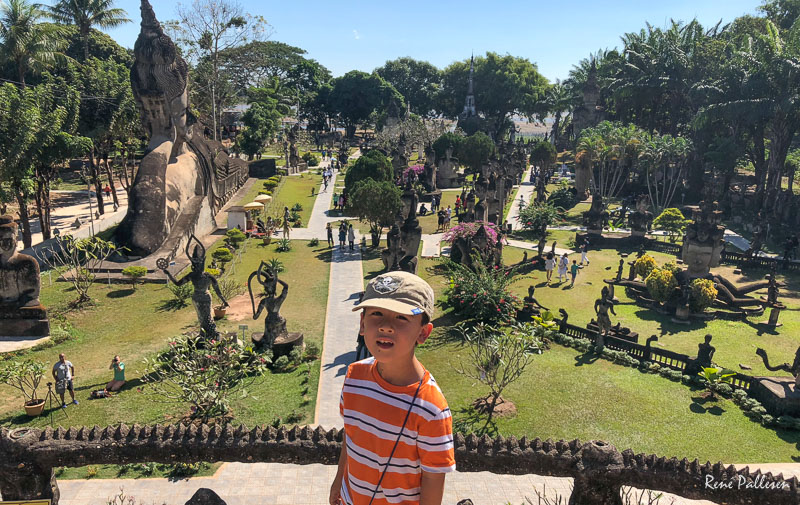 It is actually a nice little area and quite interesting with lots of (to us) weird statues showing bizarre things. 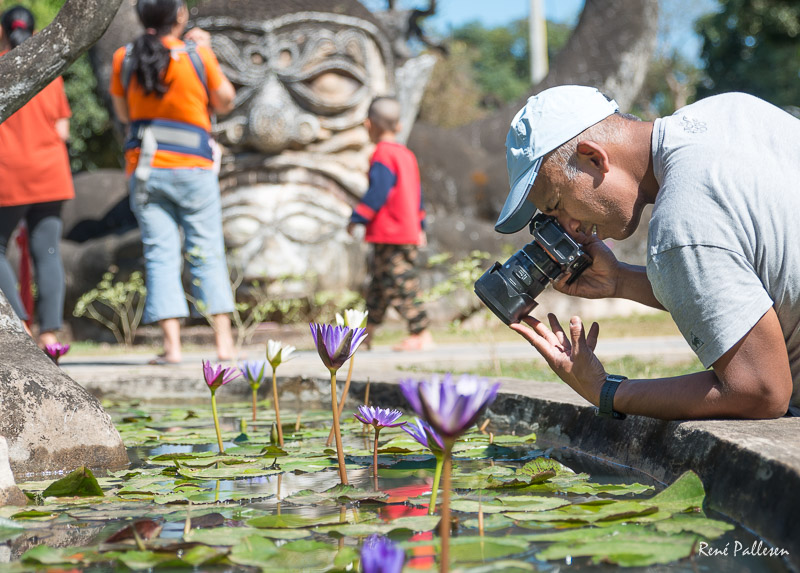 The most obvious is the massive 'pumpkin' at the entrance that you can climb. Each level inside the the sculpture itself represents hell, earth and sky. 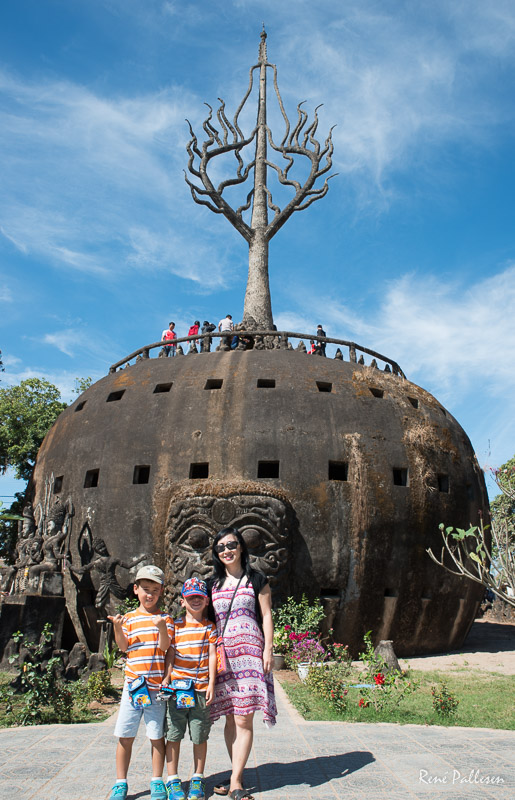 The entrance is a head with a clock above it - meaning swallowed up by time? 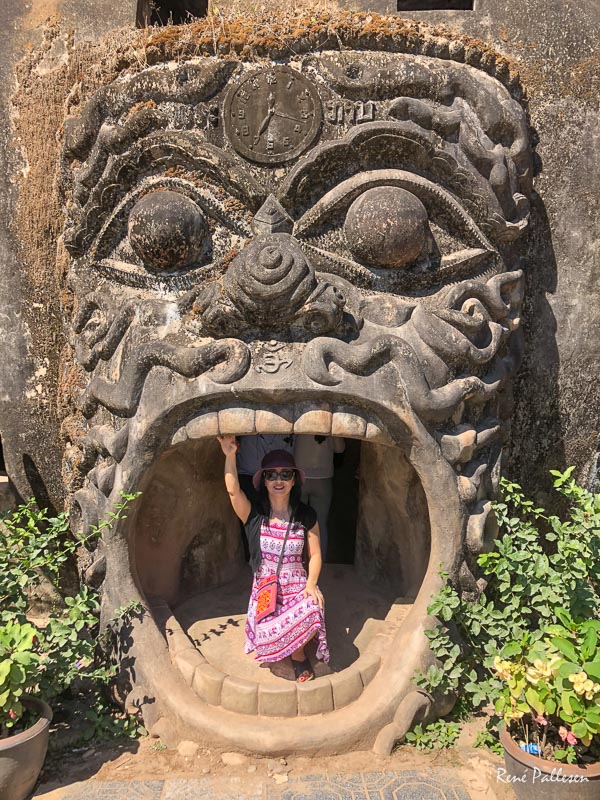 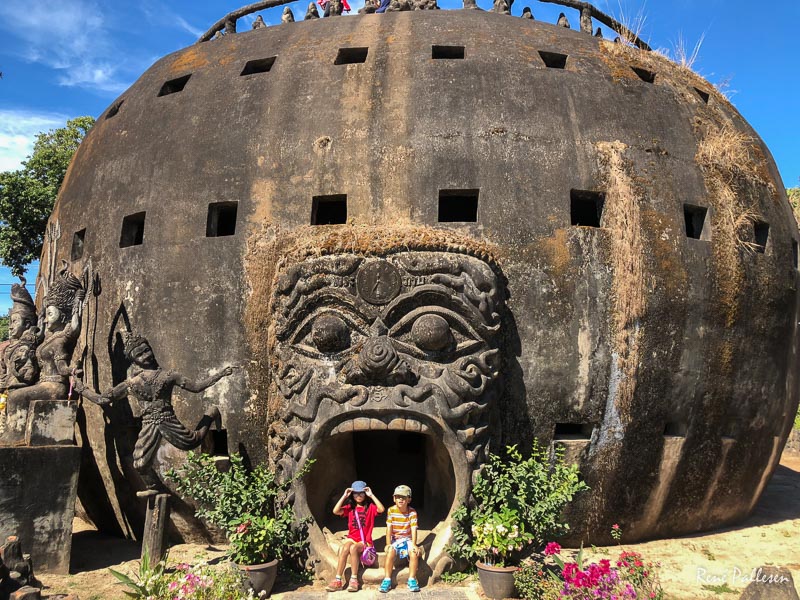 There is also a massive reclining buddha. 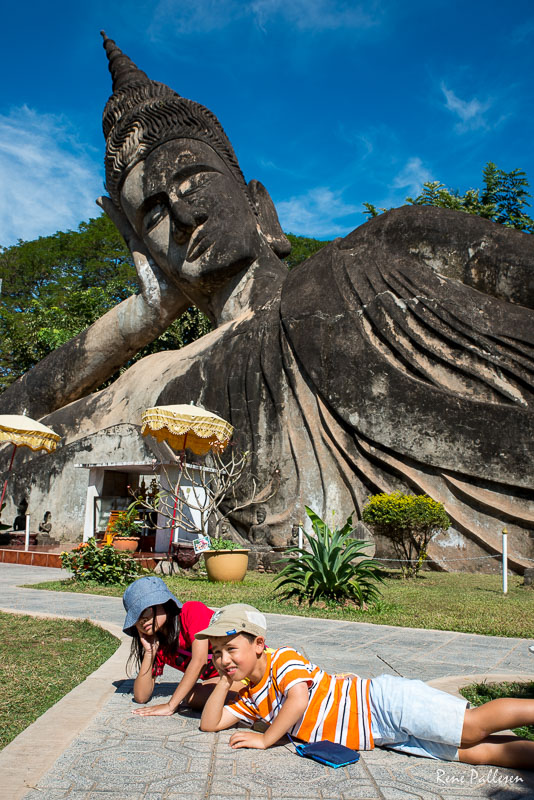 And my favourite was the large centre sculpture carrying the body of a woman...no idea what this is supposed to represent. 
2. January 2018 09:01
by Rene Pallesen
0 Comments
Vientiane is no longer the sleepy capital city it used to be. It is hustling and bustling with people, cars, motorbikes and shops everywhere. 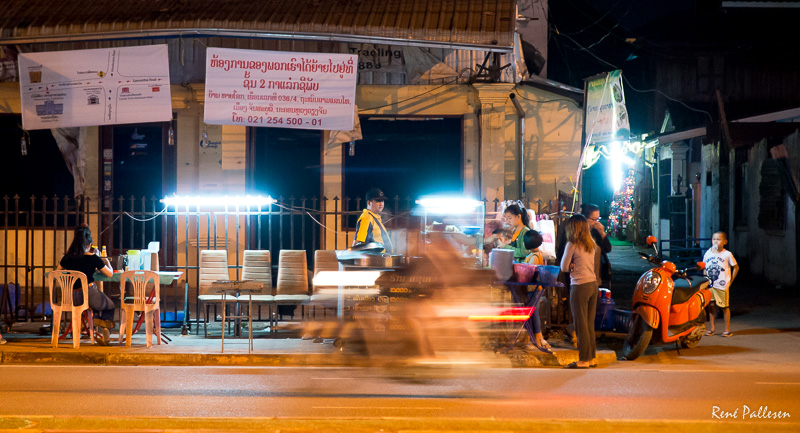 The once neglected colonial buildings have all been renovated and the red dust flying everywhere is long gone as the roads have been paved. In the outskirts of the city high-rise office towers have started shooting up and I think that given another decade this city will look like any other East Asian capital. 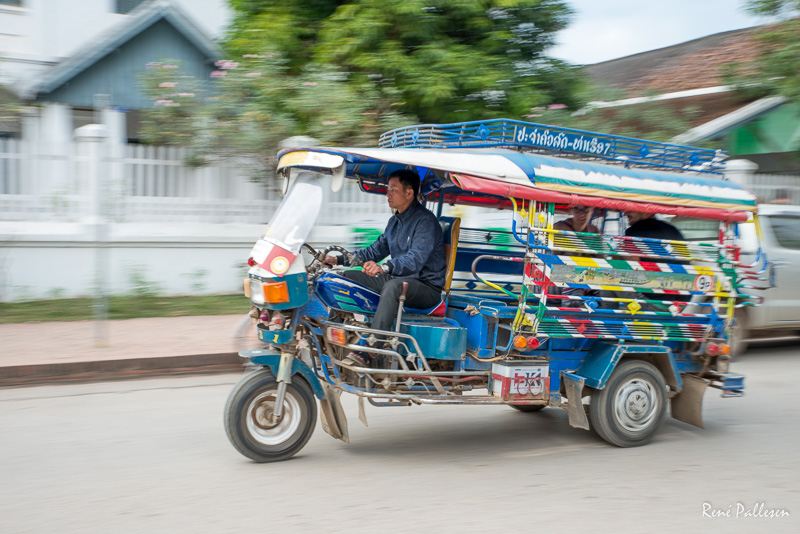 The most striking difference was the banks of the Mekong River. Last time I was there it was really just a dirty path and following it north long enough there would be a string of wooden shacks with local restaurants that would serve some beautiful local dishes, fish and other seafood. The water then would come right up to the bank and the boats could pull up and during the day the local kids would jump from the trees and swim in the river. The old path has been replaced by a modern walk way (which actually is really nice) and the shacks have been replaced by some bars closer to the centre catering more for a western clientel - still with some nice seafood on the menu. The water of the Mekon has receeded and there is now a massive sand bank moving the river 2-300 meter back from the city. Although Vientiane doesn't have a massive amount of things to see, it is definitely worth a visit. The Wats are beautiful and the vertical runway (local Arc de Triumpe - called so because they used cement intended for building an airport) is worth the climb to get a view of the city (and the main road which used to be the only paved road). There is certainly plenty to do for a couple of days. 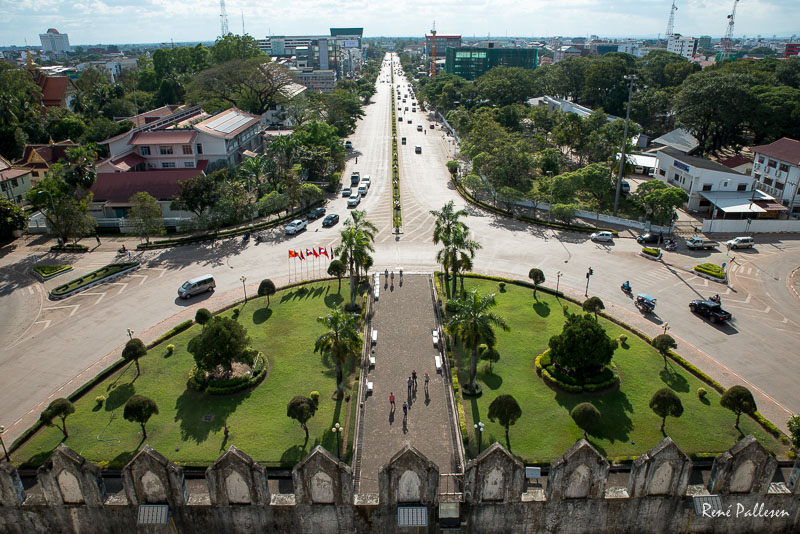 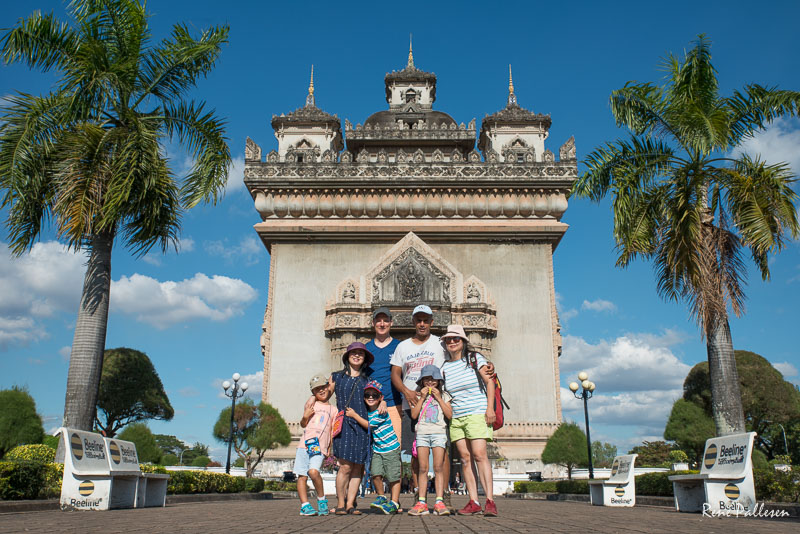 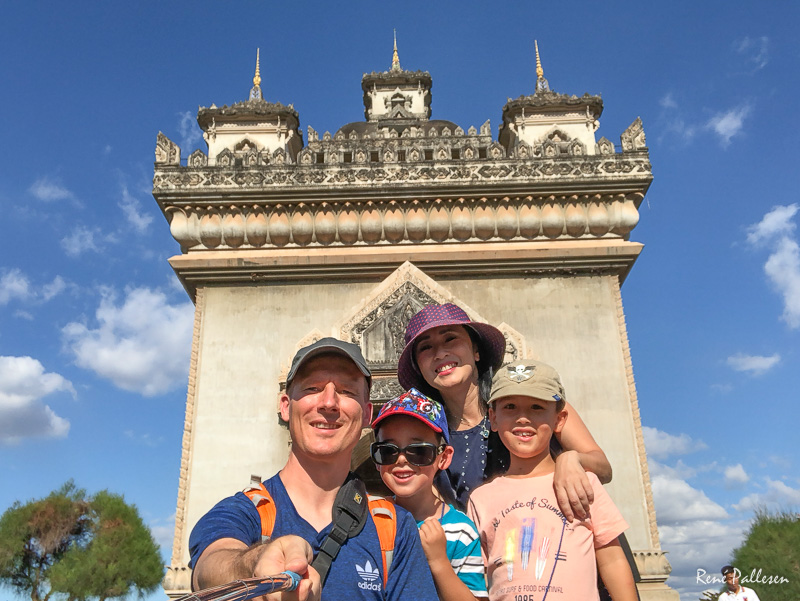 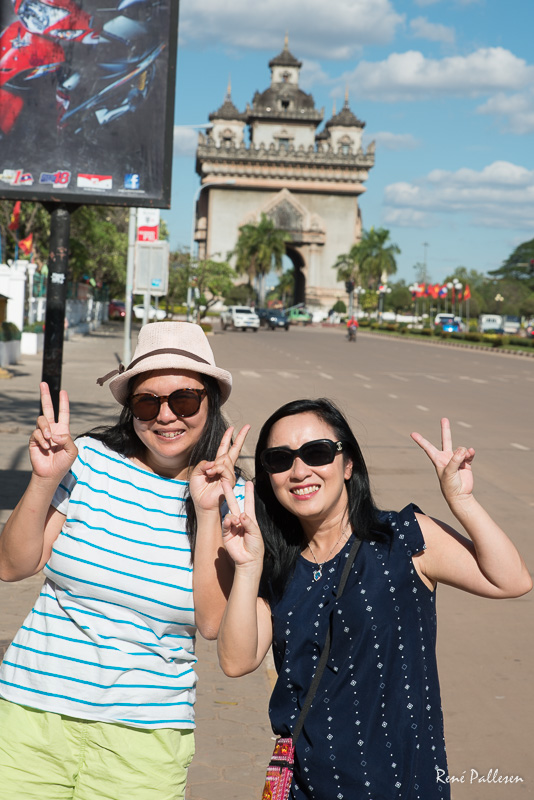 About 100 meters from the Arc down a side street we had what was probably the best noodle soup of the whole trip. It was just a local mum, dad and grandma run place and it met the critia of being busy having locals eating there which means that it is likely that the food is good and relative fresh. 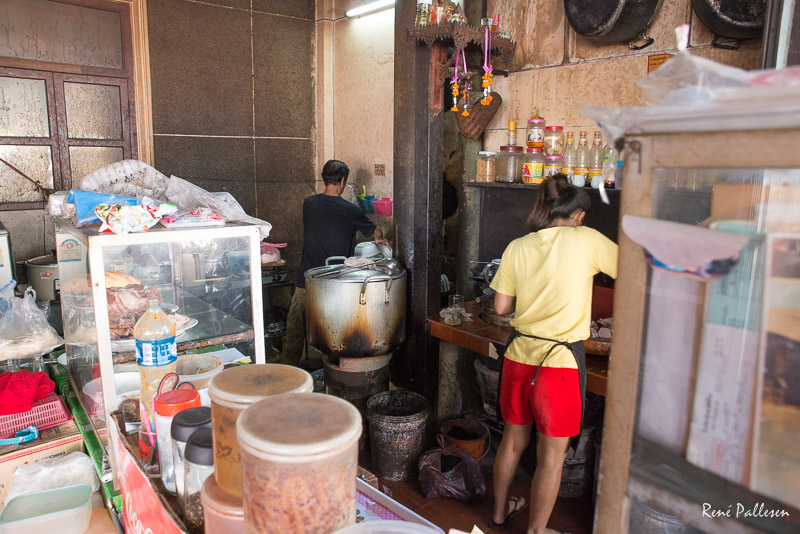 Even with it being in the middle of the city there was no access to gas or running water, so everything was cooked over wood fired stoves with the broth for the soups likely cooking overnight and the rest cooked fresh on the spot.  On the first afternoon we were sitting in a local coffee place and I started speaking to the girl working there. I asked her for local places to eat great authentic Lao food - not touristy. She recommended a place up neat That Dam (the black stuba) called Soukvinam and she showed me some photos. It looked more like a fine dining place, but the food looked delicious so we decided to give it a go.  It was a quiet place with a nice ambience. We were sitting outside in the courtyard which was ideal with the kids. We ordered a lot of food sticking to specialties we had never tried before such as stuffed frogs, fermented fish eggs etc. and it was all really nice.  By Lao standards it probably wasn't cheap, but for the whole group of us the entire meal ended up costing approximately $100 AUD. On that 'note' it is easy to be an instant millionaire as a foreigner in Laos - change $150 Australian dollars you are there.  We also celebrated New Years Even in Vientiane which was fairly low key with a couple of late night drinks. 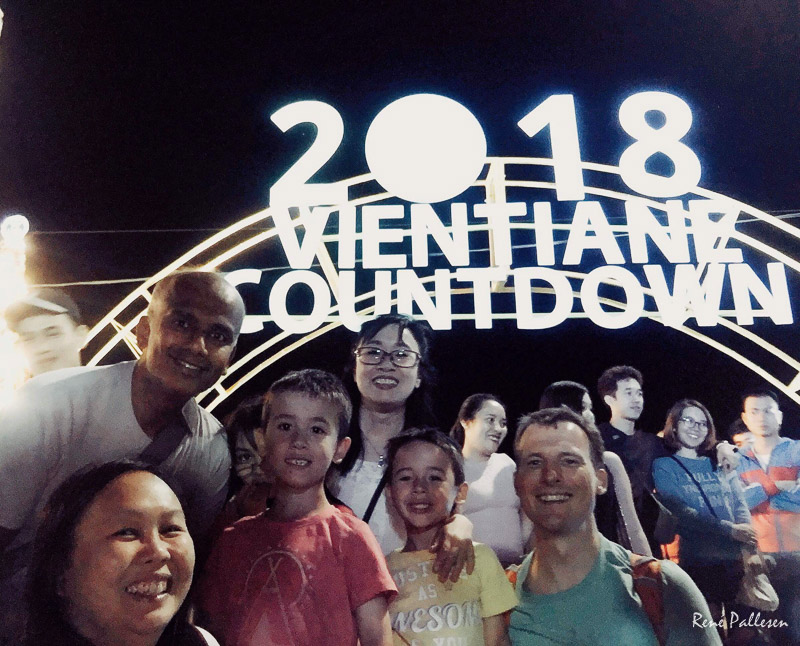 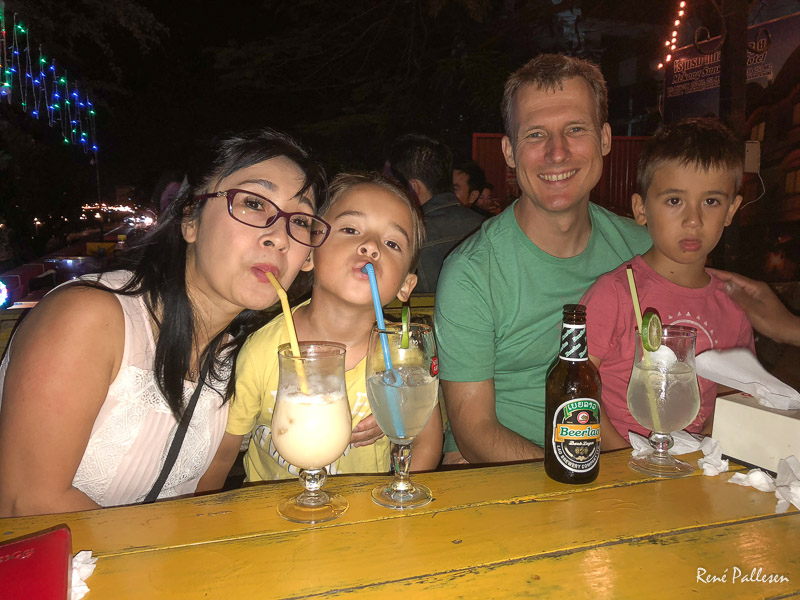 
1. January 2018 21:01
by Rene Pallesen
0 Comments
This year our holiday was going to a country in South East Asia called to the Laos with the boys and some close friends. I went there almost 20 years ago. I had just migrated to Australia and was going on my first holiday. Laos which had only just been opened up by the communist regime, was very much undeveloped after two decades of isolation and happened to be one of the first places I visited in Asia and it was a country that I immediately fell in love with.
It wasn’t the things to see and do in the country that I fell in love with - but the people. I loved the smiles, how welcoming everyone was, and I especially loved the joy of the dirty kids playing in the streets. Everyone
was living at very simple lifestyle and yet everyone had what they needed and were happy.

Back then I had no firm plans, but made them up as I went along. I traveled light, caught local transport, I met locals and other travelers along the way on a budget of less than $10/day, and still remember the sticky rice sold to passengers when passing through towns. 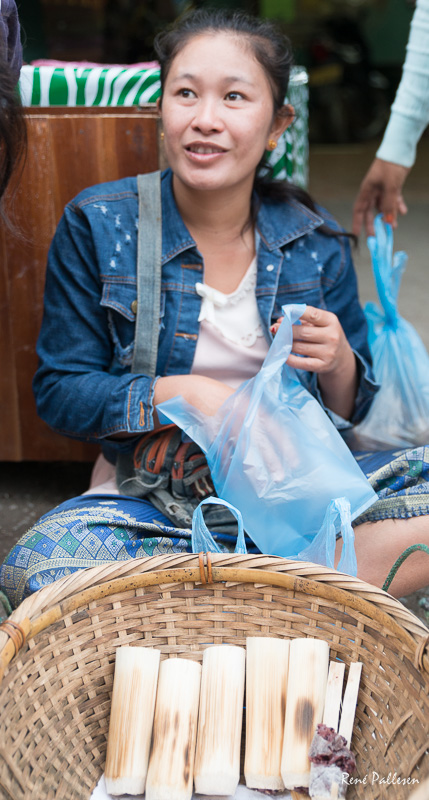 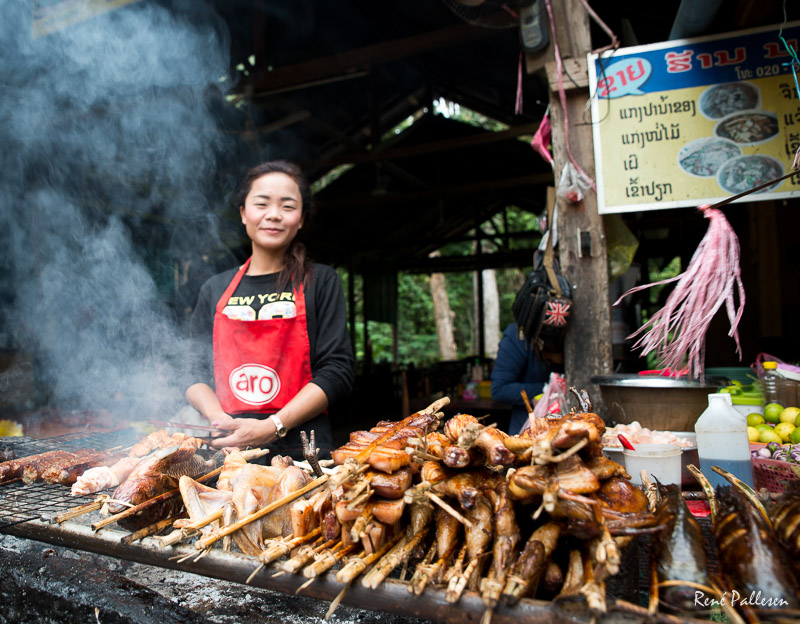
I had some incredible experiences in an amazing country. I managed to have a full busload full of locals break down laughing from me trying to read up sentences from my little pocket Lao phrase book. Through this I was invited to visit families and join their local celebrations through festive events. The only local I met up in Northern Laos who could English was a girl working for an NGO. She invited me to join her visits to remote local villages where we had to cross the rivers on bamboo rafts to get to them and experienced the local dragon boat racing.
Since this distant time I had heard and lots about the country from other travelers including my Mum and Dad who visited the country ten years ago. I heard how the country had changed and how mass tourism had ruined the
experience. I had heard about the young backpacker rave parties, the drugs and adrenaline junkies in Vang Vieng. I heard about the modernization, cars and traffic in Vientiane.
Going back with family and friends I was worried that they wouldn’t see the country that I saw so many years ago. There isn’t a lot of historical sites to see in Laos other than in Luang Prabang where there are lots of Temples due to many wars destroying major parts of the country. More worried was I that I would be disappointed by the country and the people I saw back then being no more. 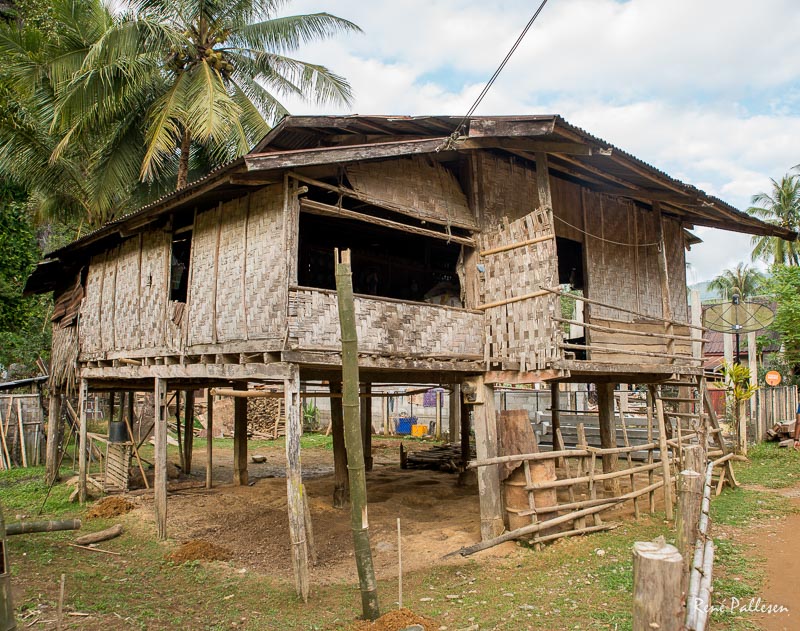
When we got there it turned out that, yes, the country has changed a lot. Lots of roads have been paved, there are lots of cars everywhere, the old colonial buildings have been renovated and all the houses are now built in brick and mortar instead of being wooden bamboo shacks. People are on mobile phones, the kids are watching youtube videos, every hotel has wifi, you can buy everything, and major investments are flowing in from neighboring Thailand, China and Vietnam.
There are a lot more tourists in the country, especially in Vang Vieng and Luang Prabang, but they are a different type of tourists than the ones I was dreading.The backpackers have been replaced with mainly adrenalin loving Korean tourists or wealthier middle-aged Europeans and the era of party fueled backpacker tourism is largely gone. 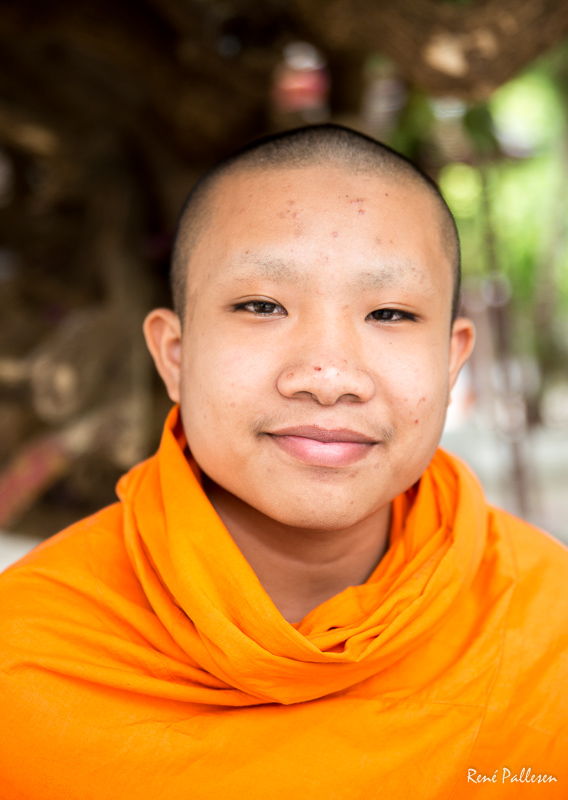
And most importantly getting outside the towns, the Laos I loved back then still very much exists if you go look for it. The modern tourists are surprisingly easy to avoid. They all stay in the same places and visit the same top ten sites or visit the same restaurants that Tripadvisor recommended they go to. They go back home and tell everyone that they have experienced Laos, not knowing that their comfort has eluded them of
the real magic of Laos. 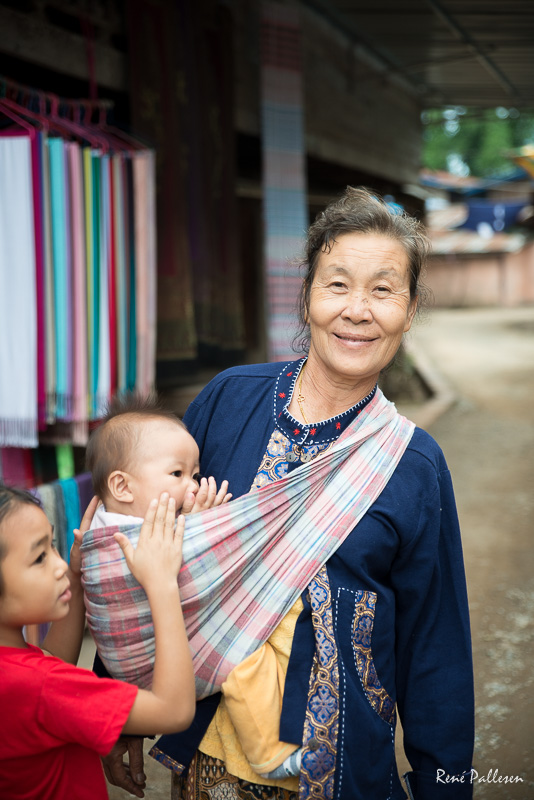
The Lao people everywhere are still very loving, smiling and friendly, there are dirty kids, chickens, cows, dogs and cats roaming the streets everywhere and the remnants of the old tribes that I saw
back then still exists through their ancient traditions although the traditional costumes and houses are largely gone now due to government policies. 
Had we gone even further afield that we did on this trip, I’m convinced that little has changed in those villages I once visited two decades ago.
Prior to going I was scared what I would find there, but now I feel blessed that my family and friends have experienced some of the glimpses of ‘my’ Laos together with me…Laos still has a big place
in my heart.
nging in concentric circles. Arabic inscriptions in gold were
painted on the ceiling. Women had to be suitably attired and could not
wear sleeveless tops or short skirts or shorts. In one corner lay the
sarcophagus of Muhammad Ali - the builder of the mosque and an albanian
mercenary who was the founder of the dynasty that ruled till the revolution
in 1952.
Cairo Egyptian Museum
I
have memories of wandering around this museum, peering into smudged
glass cases, staring into the shrivelled faces of some once well-known
pharaoh like Ramses II and wondering if the ancient Egyptians were giants
in their large coffins.
20
years later, it was almost impossible to push through the crowds of
tourists - only useful because their guides provided more information
than ours. With only two hours, there was no way that we could view
the whole museum or see the royal mummies.
The museum
was celebrating its centenary and there was a special exhibition dedicated
to TutAnkhAmun - the most famous archaeological find. With travel guide
in hand, we oohed and ahhed over the gold treasures found in his tomb
- a gold throne featuring the famous scene of TutAnkhAmun's queen anointing
him, chests made out of ebony ivory, cheetah-skinned hunting shields,
bows, arrows, alabaster canopic jars holding King Tut's mummified organs,
gold sarcophagus - if Howard Carter had found such treasures for a little
known boy-king, imagine what the tomb of a pharaoh like Ramses II would
have been like? King Tut's inner coffin of solid gold and the famous
mask of gold that everyone wants to see and is portrayed in many egyptian
images.
The museum
has become another money-making expedition for the Egyptians with an
exhorbitant price to view the royal mummies. We had to content ourselves
with the animal mummies - cats, dogs, birds, goats, Nile perch (yes,
fish as well!) and most amazing was a 7-metre crocodile mummy.
The exhibitions
were arranged by themes on the upper floor and chronological on the
lower floor, going clockwise from the Old Kingdom, to the Middle and
finally to the New and later kingdoms. There were rooms full of giant
sarcophagi that would've weighed a tonne each, a room full of miniatures
showing the egyptians' daily lives, a room full of ancient papyrus long
faded and rooms full of bits and pieces from ruins, statues, palace
floors - a place where one needs a days to spend with a decent travel
guide.
|
Khan Al-Khalili
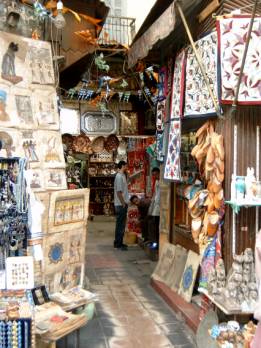 After
a stop at an egyptian perfumery and some lunch,
we headed to Khan Al-Khalili - the oldest
bazaar in Egypt that has lasted since the 1300s. Ancient buyers visited
the khan for goods brought in on merchant caravans. No longer do we
find slaves, silk, jewels or diamonds, but wooden guitars, brightly
patched pouffe covers, clothes, t-shirts, crappy papyrus paintings,
bongs/water pipes, bright bolts of cloth, the aroma of spices is very
much present and stalls are heaped with bright red, gold and blue powders
and sacks of seeds pods. Coppersmiths hammer out platters, tureens,
coffeepots and enormous crescent-shaped tops for minarets. It is a ritual
of the bazaar to expect to bargain - locals or foreign visitors - usually
a 10th of the offer price - if you have paid a third, you have paid
too much. We had only an hour to spare but many of the shops were closed
for a siesta after lunch. Ulla I pointed to bags of multicoloured
spices. He wanted £50 (AUD$10, 50DK.Kr) and after I said "da
ketir awi" (it costs too much) and walked away, the shopkeeper
doggedly followed us for a kilometre reducing the price from £40
to £30, £25, £20 and after we shouted £10 in
jest, he offered £15, £10 and finally £5 before finally
giving up on us. After much haggling, we managed to bargain for two
ornate glass perfume bottles for £20 (AUD$2.50; 20DK.Kr) After
a stop at an egyptian perfumery and some lunch,
we headed to Khan Al-Khalili - the oldest
bazaar in Egypt that has lasted since the 1300s. Ancient buyers visited
the khan for goods brought in on merchant caravans. No longer do we
find slaves, silk, jewels or diamonds, but wooden guitars, brightly
patched pouffe covers, clothes, t-shirts, crappy papyrus paintings,
bongs/water pipes, bright bolts of cloth, the aroma of spices is very
much present and stalls are heaped with bright red, gold and blue powders
and sacks of seeds pods. Coppersmiths hammer out platters, tureens,
coffeepots and enormous crescent-shaped tops for minarets. It is a ritual
of the bazaar to expect to bargain - locals or foreign visitors - usually
a 10th of the offer price - if you have paid a third, you have paid
too much. We had only an hour to spare but many of the shops were closed
for a siesta after lunch. Ulla I pointed to bags of multicoloured
spices. He wanted £50 (AUD$10, 50DK.Kr) and after I said "da
ketir awi" (it costs too much) and walked away, the shopkeeper
doggedly followed us for a kilometre reducing the price from £40
to £30, £25, £20 and after we shouted £10 in
jest, he offered £15, £10 and finally £5 before finally
giving up on us. After much haggling, we managed to bargain for two
ornate glass perfume bottles for £20 (AUD$2.50; 20DK.Kr)
|
Bedstemor's Birthday Feast
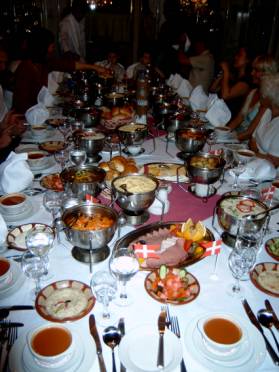 Irene
Ole had organised a private room for Bedstemor's
birthday party. A single long table in a room of egyptian style.
Small silver pots lined in two rows in the middle of the table kept
the food warm. Irene
Ole had organised a private room for Bedstemor's
birthday party. A single long table in a room of egyptian style.
Small silver pots lined in two rows in the middle of the table kept
the food warm.
We feasted on cumin-flavoured fried fish,
chicken fillets egyptian-style, cinammon-flavoured ravioli, rice, mashed
potatoes and beef steaks in pepper sauce, sang and toasted with bottles
of egyptian wine and beer to Bedstemor.
Whilst the children played in one corner,
there was much chatter througout the table and the evening finished
off with chocolate and fruit cakes topped with "Happy Pirthday"
(note, it's not an error) and we laughed in amusement in a plethora
of egyptian sweets - baklawa, semolina tarts, rose-water flavoured tarts,
and tarts that tasted like liquid honey... Ulla almost wanted to take
the rest of the desserts with her (except for the rose-water flavoured
ones - it was funny to watch her expression - rosewater almost smells
like cosmetics). The waiters were extremely attentive, coming by every
two minutes to serve us.
Best of all, Bedstemor turned 2 years old,
as she blew out each candle on the cakes. As the danes would say, "det
var meget hyggeligt!" (it was cozy)
|
Monday 15. november 2004 (7:30am start)
From the brown buildings and streets of
Cairo, we travelled 24km southeast of the city to Saqqara, changing
from a uniform brown to lush green fields of large cabbages and hundreds
of date palms. It was like an oasis, a gentle mist gave a surreal sense
of the fertile plains of ancient Egypt. Women in full-length black abeeyas
squatted in the fields, the odd man walking around - such a contrast
to the intense crowds of central Cairo.
Saqqara's Step Pyramid
Founded as a necropolis (burial city) for
the Old Kingdom and is one of the richest archaeological sites in Egypt.
The Step Pyramid
is less that ½ the height of the largest pyramids at Giza, but
this monument served as a predecessor of the smooth pyramids. Previously
tombs were made of mud brick, rectangular slablike structure covering
a burial pit. But the architect Imhotep had the bright idea to construct
in stone and  build
the slablike structure 5 times one on top of the other, creating the
first pyramid. build
the slablike structure 5 times one on top of the other, creating the
first pyramid.
We entered through the Great South Court
- the size of a soccer field, down a corridor of 40 pillars inspired
by bundles of tied reeds. Whilst Adam was making another one of his
speeches, I was tempted by a turbaned egyptian in a dress who took me
to the top where I managed to get one shot of the magnificent pillars
up top, before being scolded by Adam and being asked for baksheesh (tip).
I was gratefully rescued by a couple of Italians when the egyptian would
not let me go without a baksheesh. However, once I surfaced from the
building, I was blinded by white sands and the immense pyramid sitting
solitary amongst a few ruined stones, with a much smaller triangular
heap of stones in the background. Although the morning had been cool,
the sun soon warmed us up as we wandered round to the north.
|
Memphis
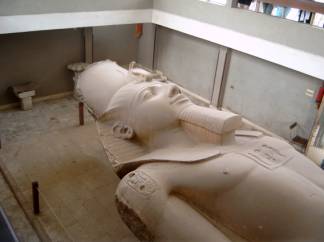 Once
the capital of ancient Egypt, it remains unexcavated
due to villages built on top of it and a high water table as a result
of the Aswan Dam. There is a small garden with small finds - bits and
pieces but the most exciting thing to see is a colossus of Ramses II
lying on his back as the lower legs are missing. The colossus would've
been 5 stories high had it been standing. Nearby lies the largest alabaster
statue ever found - 80 tons of sphinx - imagine what treasures that
could've been found if Memphis could've been excavated, especially as
this ancient city lay halfway between Upper and Lower Egypt. Once
the capital of ancient Egypt, it remains unexcavated
due to villages built on top of it and a high water table as a result
of the Aswan Dam. There is a small garden with small finds - bits and
pieces but the most exciting thing to see is a colossus of Ramses II
lying on his back as the lower legs are missing. The colossus would've
been 5 stories high had it been standing. Nearby lies the largest alabaster
statue ever found - 80 tons of sphinx - imagine what treasures that
could've been found if Memphis could've been excavated, especially as
this ancient city lay halfway between Upper and Lower Egypt.
Our final stop before lunch was a papyrus
museum - another place of commission for Adam. Bedstemor purchased a
papyrus of egyptian alphabets. Some of the paintings cost a massive
£3,500 (AUD$900, 3,500DK.Kr). For lunch, we had a splendid egyptian
meal in the middle of nowhere that served excellent mezza (egyptian
tapas) of baba ghanoush (roasted eggplant dip), tzatziki (cucumber dip),
hummus (chickpea dip), fuul (beans) served with freshly made pita bread,
warm vine-leaf rolls, lamb kofta and freshly roasted chicken in thyme.
It was feast fit for a king and the most egyptian meal we had on the
whole trip.
|
 Pyramids
of Giza Pyramids
of Giza
From air the desert pyramids were
right on the edge of the city, 16km from Cairo.
I remember vaguely, as a child, hunched
over, walking up a surprisingly warm shaft lit by a single light bulbs
and emerging into a very chilly dark room that held a single stone sarcophagus,
the room empty except for occasional square holes in the wall where
food was left for the afterlife.
I had entered the Queen's chamber in the
largest pyramid and 20 years later, only the first 300 can enter these
pyramids - for an exhorbitant fee. |

The largest of the three, Cheops' pyramid was
the largest, standing at 146metres at one point, took 920 metres to
walk around it and contained 2.3 million blocks! Each block was at least
one metre high, so you can imagine how massive these pyramids were.

The 2nd largest, Khefren's (Cheop's son) pyramid
still had some of the smooth shiny limestone casing that once used to
cover all these pyramids.==>
The massive solar boat that once carried
the pharaoh's body from Memphis to Giza and the
three smaller Queens' pyramids stood at one corner of the massive Cheop
pyramid. We didn't have the opportunity this time to enter the tombs,
but I feel priveleged that I did and that I still have some memories
of the event.
|
The Sphinx
 The
pyramids loomed in the background as it sat silently on the hot sand
under the glaring sunlight for 4,000 years. Napoleon's troops once used
it for target practice, so its nose and pharaohs beard and long fallen
off and lies in a British museum. The Greeks called it "the
Sphinx" as it was based on a mystical creature with the head
of a man and body of a lion, which would stop any traveller along the
way with a riddle - if the riddle wasn't answered, it became the sphinx's
dinner. Throngs of crowds surrounded the sphinx and we could only enter
in single file. Over time, it seemed that tourists could view it from
further and further away. 45 years ago, Bedstefar's (grandfather) could
touch the Sphinx and even climb to the top of the pyramid; 20 years
ago, it was simply surrounded by a small wire fence but I could stand
close up to it; now it lay in a very large pit where visitors could
only view it up close if they zoomed in on their cameras. 4 millenia
later, it still manages to awe all of us. The
pyramids loomed in the background as it sat silently on the hot sand
under the glaring sunlight for 4,000 years. Napoleon's troops once used
it for target practice, so its nose and pharaohs beard and long fallen
off and lies in a British museum. The Greeks called it "the
Sphinx" as it was based on a mystical creature with the head
of a man and body of a lion, which would stop any traveller along the
way with a riddle - if the riddle wasn't answered, it became the sphinx's
dinner. Throngs of crowds surrounded the sphinx and we could only enter
in single file. Over time, it seemed that tourists could view it from
further and further away. 45 years ago, Bedstefar's (grandfather) could
touch the Sphinx and even climb to the top of the pyramid; 20 years
ago, it was simply surrounded by a small wire fence but I could stand
close up to it; now it lay in a very large pit where visitors could
only view it up close if they zoomed in on their cameras. 4 millenia
later, it still manages to awe all of us.
|
Tuesday 16. november 2004 (2:30am start)
Yes, you did read that right - we were
all waiting in the lobby at 2:30AM. Last night, Bedstemor's grandchildren
treated the family to a Spanish-Egyptian Italian
dinner, which was followed by a  cacophany
of tambourines, oboes and drums played for an Egyptian engagement couple
in the lobby. cacophany
of tambourines, oboes and drums played for an Egyptian engagement couple
in the lobby.
This morning we were flying to Aswan, to
board a 3-day cruise up the Nile, sailing up to Luxor. When we arrived,
we were taken for a short felucca ride along
the Nile with a fantastic view of the Tomb of Nobles.
When we returned we were given our rooms onboard a four-storey cruise
ship that had an indoor games room, a pool and sundeck at the top.
Even from our rooms right at the bottom, we had a magnificent view of
a small white mosque-like structure on top of huge sandy mountains dotted
with small caves.
In the evening we had the opportunity to
visit a small souq (local bazaar) selling t-shirts, papyrus paintings,
mounds of saffron and dry scented lotus flowers, brown, red, yellow
indigo mounds of fragrant spices - all of which some of us bargained
for - the most expensive £25 papyrus painting (AUD$5, 25DK.Kr)
to cheapest £15 embroidered t-shirts with hieroglyphics (AUD$3,
15DK.Kr). To top the evening off, we took a £5 horse carriage
ride back to the ship. |
 
|
Wednesday 17. november 2004 (7:30am
start)
It seemed some of the family had succumbed
to a tummy bug. The rest of us steered clear of unwashed fruit, fresh
salads, raw vegetables and drinks made with local water. However, this
didn't stop us from going out to see a few sights.
The Unfinished Obelisk
Had this obelisk
been completed, it would've been the largest and heaviest ever made
standing at 142 metres. It sat in a granite quarry, perfectly complete
on three sides but abandoned when a flaw was found in the stone. It
is almost impossible to imagine how the ancient egyptians could've moved
even a single rock made from this quarry as it stood a great many miles
from any of the monuments ever made. Unfortunately for Egypt, most of
its obelisks have been spirited to other countries - to Italy, Britain,
France and even Argentina by foreign archaeologists in the last centuries.
Most of us didn't have the chance to view the complete obelisk before
Adam rang a bell that he carried (to annoy us I suppose) |
 
|
High Dam
 For
centuries the Nile controlled the Egyptians' lives - either flooding
or insufficient water levels were disastrous for the people who relied
on this huge water source for their livelihood. When the Aswan
Dam was built, some of the villages in the south lost their water
supply. For
centuries the Nile controlled the Egyptians' lives - either flooding
or insufficient water levels were disastrous for the people who relied
on this huge water source for their livelihood. When the Aswan
Dam was built, some of the villages in the south lost their water
supply.
30 years ago, a new High Dam was built
which resulted in the man-made Lake Nasser to the south being created
==>
This meant many people had to be moved
as villages were buried, as well as some of the ancient egyptian monuments
such as the Temple of Philae. |
 At
its highest point, the High Dam stands at 111m high, 3.8km long and
980m wide at the base. At
its highest point, the High Dam stands at 111m high, 3.8km long and
980m wide at the base.
Three times the number of stones used for
Cheops' Pyramid was used.
Videoing isn't allowed as it is a high-security
military area - should there be an attack on this Dam, then much of
Egypt would be submerged under water and would be a disaster for the
country.
Given only 10min, Adam "rang"
us back to the bus. |
Temple of Philae
 After
Aswan Dam, the Temple of Philae was submerged
for six months a year and tourists had to view it through the murky
waters of Lake Philae. When the High Dam was built, it threatened to
submerge the Temple permanently, so was moved stone by stone to a new
island similarly landscaped. Philae is special in that it's only accessible
by boat and the sunset forms a spectactular backdrop. A temple dedicated
to Isis (goddess of women, sex purity), it was one of the last
outposes for paganism and due to the popularity of Isis, was also used
by the early Christians. The Temple walls and many pillars were filled
from top to bottom with hieroglyphs and images of Isis - many defaced
by the early Christians who considered ancient Egypt's gods to be "pagan".
I had a fantastic afternoon walking in and out of all the nook and crannies
- visiting the Birth House, Nilometer, the "Pharaoh's Bedstead"
and much to the amusement of the family, I was the last to emerge. After
Aswan Dam, the Temple of Philae was submerged
for six months a year and tourists had to view it through the murky
waters of Lake Philae. When the High Dam was built, it threatened to
submerge the Temple permanently, so was moved stone by stone to a new
island similarly landscaped. Philae is special in that it's only accessible
by boat and the sunset forms a spectactular backdrop. A temple dedicated
to Isis (goddess of women, sex purity), it was one of the last
outposes for paganism and due to the popularity of Isis, was also used
by the early Christians. The Temple walls and many pillars were filled
from top to bottom with hieroglyphs and images of Isis - many defaced
by the early Christians who considered ancient Egypt's gods to be "pagan".
I had a fantastic afternoon walking in and out of all the nook and crannies
- visiting the Birth House, Nilometer, the "Pharaoh's Bedstead"
and much to the amusement of the family, I was the last to emerge.
|
 Kom
Ombo Kom
Ombo
The ship set sail from Aswan at 3:45pm
after an afternoon spent sunbaking and drinking beer (typically danish
to make the most of sunshine and beer). We were sailing 48km north of
Aswan to Kom Ombo - the site of an ancient
city devoted to the worship of a crocodile god, Sobek. The ancient city
is long gone and crocodiles existing on nearby sandbanks have been hunted
to extinction.
At sunset, we visited the Temple of Kom
Ombo, dedicated to both Sobek the Crocodile god and Horus, the falcon-headed
sky god Isis' son. Although we didn't have the opportunity to
explore this  temple,
it was both spectacular and eerie at sunset, with large light illuminating
it. There existed a pit filled with water, with a platform halfway down,
where crocodiles were lured in from the Nile with human flesh, and the
largest crocodile was caught and mummified as a tribute to Sobek. At
the Chapel of Hathor (Horus' wife), an American shouted "Geez,
I thought I was supposed to see crocodile statues!" *laugh* It
contained two of the mummified crocodiles found at the Temple. temple,
it was both spectacular and eerie at sunset, with large light illuminating
it. There existed a pit filled with water, with a platform halfway down,
where crocodiles were lured in from the Nile with human flesh, and the
largest crocodile was caught and mummified as a tribute to Sobek. At
the Chapel of Hathor (Horus' wife), an American shouted "Geez,
I thought I was supposed to see crocodile statues!" *laugh* It
contained two of the mummified crocodiles found at the Temple.
We returned to a small cocktail party before
dinner, provided by the ship to introduce all the staff responsible
for making our trip enjoyable.
|
Thursday 18. november 2004 (7am start)
We sailed overnight past Kom Ombo to Edfu,
a small regional center for the sugarcane trade, visited the Temple
of Horus and sailed on to the Lock-crossing at Esna.
Temple of Horus
 This
is the most complete of its kind, a Greco-Roman
temple that conforms exactly to ancient egyptian principles of architecture
ie visit Edfu to see what almost every other temple in Egypt would've
looked like in its original form. We were awed by the massive walls
of the pylons at the entrance, distince reliefs showing mirror images
of Horus and the pharaoh grasping the hair of his enemies. It was built
by Cleopatra's father around 50yr BC. Standing in the forecourt of this
well-preserved temple we can see mud-brick houses lined up at the top
of the compound walls because this temple was once buried right up to
the ceiling with a village built on top of it. Many of the temple relifes
capture the cataclysmic battle of Horus with his brother Seth. We entered
a small Nilometer - a dark, dank tunnel that smelled of pee and was
once used to measure the level of the Nile. Again I was the last to
emerge (a couple of minutes late only) to the loud applause of everyone
(and a huge glare from Adam). This
is the most complete of its kind, a Greco-Roman
temple that conforms exactly to ancient egyptian principles of architecture
ie visit Edfu to see what almost every other temple in Egypt would've
looked like in its original form. We were awed by the massive walls
of the pylons at the entrance, distince reliefs showing mirror images
of Horus and the pharaoh grasping the hair of his enemies. It was built
by Cleopatra's father around 50yr BC. Standing in the forecourt of this
well-preserved temple we can see mud-brick houses lined up at the top
of the compound walls because this temple was once buried right up to
the ceiling with a village built on top of it. Many of the temple relifes
capture the cataclysmic battle of Horus with his brother Seth. We entered
a small Nilometer - a dark, dank tunnel that smelled of pee and was
once used to measure the level of the Nile. Again I was the last to
emerge (a couple of minutes late only) to the loud applause of everyone
(and a huge glare from Adam).
|
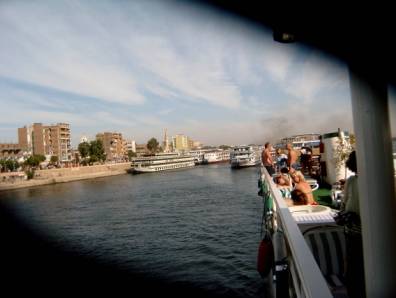 Returning
to the ship in time for the 9am sail, we set off for Esna, 48km south
of Luxor. Whilst the family tanned on the sundeck,
I sat in the sun at the front of the boat, enjoying sense of peace and
tranquility. It was truly beautiful to sit on a boat not too big or
small, to watch the changing scenery on both sides, passed fields of
giant palms and lush green fields, a smoking metal, the ship moving
at a leisurely 16km/hr and passing some incredibe mountains of sand
and cliffs. Ole joined me for a chat - he Irene are moving to
Greenland on Tuesday. Later in the morning, I joined René and
Ulla by the pool, gossiping about Bedstefar and family resemblances,
watching Vinnie's kids and Sebastian splash about the pool, Lonnie,
Sarah Birit stripped down to the minimum to get a bit of colour. Returning
to the ship in time for the 9am sail, we set off for Esna, 48km south
of Luxor. Whilst the family tanned on the sundeck,
I sat in the sun at the front of the boat, enjoying sense of peace and
tranquility. It was truly beautiful to sit on a boat not too big or
small, to watch the changing scenery on both sides, passed fields of
giant palms and lush green fields, a smoking metal, the ship moving
at a leisurely 16km/hr and passing some incredibe mountains of sand
and cliffs. Ole joined me for a chat - he Irene are moving to
Greenland on Tuesday. Later in the morning, I joined René and
Ulla by the pool, gossiping about Bedstefar and family resemblances,
watching Vinnie's kids and Sebastian splash about the pool, Lonnie,
Sarah Birit stripped down to the minimum to get a bit of colour.
|
 We
reached Esna and used the few hours to get off the ship and stretch
our legs after a morning of lazing around the pool. I was itching to
walk around Esna, away from tourists and see how the locals lived. René
and I headed for the quieter streets avoiding the busy streets
around a souq. We were followed by a few children clad in long grey
or white robes, who guided and annoyed us. Most of the narrow streets
were unpaved, some very muddy and smelling of manure. Skinny, skeletal
donkeys balanced again flat wagons, many shy girls waving from the darkness
of their doorways or 2nd-level windows, whilst little boys came out
to say hello and mill around us. Most houses were simple of mud bricks,
with tiny wooden shuttered windows to keep the intense summer heat out.
Some had extremely ornate wooden doors, reminiscent of colonial days.
Occasional peek in doorways revealed empty mud-lined rooms as most people
lived in the upper floors. Eventually René shouted imshee! (go
away) as the kids got noisier, more aggressive, pulling on our arms
and throwing pebbles at us. When I stumbled over a whimpering black
and white disease-ridden puppy in brown paper, it was kicked aside -
making me almost reach out for it if René hadn't stopped me.it
was wise not to even make contact witht the children, who were dust-covered
and clad in the long egyptian grey robes. It was such a relief when
they finally left us even though we knew they were hiding in in alleyways
watching us wind through the streets. There were goldsmiths glittering
with ornate rings, earrings and necklaces; tailors still sewing by hand
on the steps of their shop; coffee houses filled with solitary men smoking
their water-pipes - their eyes following us down the street. We had
spent so much time just sitting around that it was good to get away. We
reached Esna and used the few hours to get off the ship and stretch
our legs after a morning of lazing around the pool. I was itching to
walk around Esna, away from tourists and see how the locals lived. René
and I headed for the quieter streets avoiding the busy streets
around a souq. We were followed by a few children clad in long grey
or white robes, who guided and annoyed us. Most of the narrow streets
were unpaved, some very muddy and smelling of manure. Skinny, skeletal
donkeys balanced again flat wagons, many shy girls waving from the darkness
of their doorways or 2nd-level windows, whilst little boys came out
to say hello and mill around us. Most houses were simple of mud bricks,
with tiny wooden shuttered windows to keep the intense summer heat out.
Some had extremely ornate wooden doors, reminiscent of colonial days.
Occasional peek in doorways revealed empty mud-lined rooms as most people
lived in the upper floors. Eventually René shouted imshee! (go
away) as the kids got noisier, more aggressive, pulling on our arms
and throwing pebbles at us. When I stumbled over a whimpering black
and white disease-ridden puppy in brown paper, it was kicked aside -
making me almost reach out for it if René hadn't stopped me.it
was wise not to even make contact witht the children, who were dust-covered
and clad in the long egyptian grey robes. It was such a relief when
they finally left us even though we knew they were hiding in in alleyways
watching us wind through the streets. There were goldsmiths glittering
with ornate rings, earrings and necklaces; tailors still sewing by hand
on the steps of their shop; coffee houses filled with solitary men smoking
their water-pipes - their eyes following us down the street. We had
spent so much time just sitting around that it was good to get away.
Crossing of the Lock
We
set sail at 3pm and many ships like ours got together near two bridges
just north of Esna. For one hour of the day, a bridge opened up for
the ships and cars were ferried across the Nile instead. In the meanwhile,
the ship had organised a special Egyptian "Oriental" dinner
where guests could dress up in egyptian attire. It was a traditional
egyptian feast of flat bread, baba ghanoush, warm stuffed zucchini and
capsicum, warm cabbage rolls, chickpeas, lentils, fish, and traditional
dish of okra, and a dressed up rice-stuffed whole lamb with a foil-covered
head, small skinny eggplants for ears sitting upright on a silver platter.
To finish it off was a plethora of egyptian dessert - semolina tarts,
almond-milk agar (jelly) and the tartlets that tasted of liquid honey.
Between 10-11pm we all gathered together for the lock-crossing.
Canal lock-crossing
involves ships moving from a one water-level to another, usually where
a dam is involved. Two cruise ships moved into a channel that is closed
off and the water in the channel gradually reduced - in our case approx
10 metres. Once we reached the new water-level on the other side of
the lock, the door in front of the ship opened and we sailed out. The
lock-crossing took approx one hour, although all the waiting took a
few hours. It was well-worth staying up even though we had an early
start the next day. What was most amazing was the way the ship travelled
with such expertise through such a narrow channel with barely enough
space on each side.
|
Friday 19 November 2004 (7am start)
Overnight we had sailed from Esna to Luxor
arriving at approx 2am - the last port for us. We were awoken by efficient
wake-up calls and we could hear phones ringing in all the rooms going
on early tours. We had a long day ahead, cramming four different sights.
Valley of the Kings
Builders of the great pyramids realised
that hidden entrances and false shafts were not going to protect their
dead pharaohs or the riches buried with them from tomb-robbers, so from
the 18th dynasty, the ancient egyptians started digging underground.
Rolling hills and valleys of sand, rubble and solid limestone - it is
amazing to think that the ancient egyptians managed to bury something
like possibly over 300 pharaohs of which only 62 have been found (last
was TutAnkhAmun). |
 The mountain under which many of the tombs were found
has a pyramid-shaped peak. |

Our tickets allowed us to visit three tombs only and only a handful
were opened on the day with long queues at each.
We visited the tombs of Ramseses III, IX
and V/VI - all of them relatively small tombs, some partly excavated,
others quite madly damaged by humidity from all the tourists and from
oily fingers.
|
 There
was a variety of hieroglyphs and images, of the pharaohs, how they treated
their subjects, even the ceilings were beautifully adorned with dark
blue skies, thousands of stars and the sky goddess Nut, stretched above.
Tomb of Ramses III was like a picture book of "Better Homes
Gardens" with images of hundreds of pots, furniture and food preparation.
In the tomb of Ramses V/VI was a large shattered giant pharaoh-shaped
sarcophagus eerily illuminated by silver light - Ramses VI unusually
sharing a tomb with his predecessor brother. It is truly amazing
that such images have lasted thousands of years, hidden away in dark
low-humidity tombs that are quickly disintegrating since they have been
excavated. There
was a variety of hieroglyphs and images, of the pharaohs, how they treated
their subjects, even the ceilings were beautifully adorned with dark
blue skies, thousands of stars and the sky goddess Nut, stretched above.
Tomb of Ramses III was like a picture book of "Better Homes
Gardens" with images of hundreds of pots, furniture and food preparation.
In the tomb of Ramses V/VI was a large shattered giant pharaoh-shaped
sarcophagus eerily illuminated by silver light - Ramses VI unusually
sharing a tomb with his predecessor brother. It is truly amazing
that such images have lasted thousands of years, hidden away in dark
low-humidity tombs that are quickly disintegrating since they have been
excavated.
|
Colossi of Memnon
 Just
past the Valley of the Kings, we stopped to view the Colossi of Memnon
- twin 18-metre figures of Amenhotep III that once stood in front of
what was believed to be Egypt's greatest temples, even larger than the
existing Temple of Karnak. Each carved from single pieces of stone,
once famous for bell-like tone emitted each sunrise. The Greeks believed
these sounds were made by the immortal Memnon greeting his mother. After
an Roman emperor made restorations in 170AD, the sounds ceased. Just
past the Valley of the Kings, we stopped to view the Colossi of Memnon
- twin 18-metre figures of Amenhotep III that once stood in front of
what was believed to be Egypt's greatest temples, even larger than the
existing Temple of Karnak. Each carved from single pieces of stone,
once famous for bell-like tone emitted each sunrise. The Greeks believed
these sounds were made by the immortal Memnon greeting his mother. After
an Roman emperor made restorations in 170AD, the sounds ceased.
To our amusement, Adam made another one
of his commission-based stops at an alabaster
factory. He couldn't understand why we broke into laughter. Instead
of boycotting the trip, we all went rushing in for free cups of coffee.
René led a race with Sebastian and Vinnie's boys sliding across
the smooth alabaster marble floor. At the other end was Ulla being approached
with a small £10,000 alabaster hippo, to which she jokingly said
yes and the shop-assistant went away to put it aside.
|
Temple of Hatshepsut
 Lying
next to the Valley of the Kings is this temple of the only female
pharaoh who ever ruled in Egypt. Due to a botched job by an Egyptian-Polish
archaeological team, the ruined temple was recreated to resemble a bus
depot, with much of the original artwork covered over or destroyed.
The sucessor to Hatshepsut's brother/husband was stepson Tuthmose III
who had to wait 20 year to get his throne, hence when she died, she
was not mummified and her temple destroyed as punishment. The temple
was at the site of a Coptic monastery and fantastic limestone cliffs.
There may not be much of the temple to look at but the view, from up
close, far away or even from the sky is definitely worth the trip. Lying
next to the Valley of the Kings is this temple of the only female
pharaoh who ever ruled in Egypt. Due to a botched job by an Egyptian-Polish
archaeological team, the ruined temple was recreated to resemble a bus
depot, with much of the original artwork covered over or destroyed.
The sucessor to Hatshepsut's brother/husband was stepson Tuthmose III
who had to wait 20 year to get his throne, hence when she died, she
was not mummified and her temple destroyed as punishment. The temple
was at the site of a Coptic monastery and fantastic limestone cliffs.
There may not be much of the temple to look at but the view, from up
close, far away or even from the sky is definitely worth the trip.
Then we had lunch and a brief rest. I was
surprised to find that a humorous member of housekeeping had set up
towels, blanket lettuce leaves to resember a man and his snake.
I thought René had played a joke on me until I found out something
similar other family members' rooms!
|
 Temples
of Karnak Luxor Temples
of Karnak Luxor
Karnak was known
as "Ipet-Isut" - The Most Perfect of Places.
Much of it is in ruins but is possibly
the largest temple complex ever built anywhere and created over 1,500
years by successive generations of pharaohs.
It was the residence of pharaohs, place
of worship, wealthy treasury, centre of administration and employed
thousands.
Karnak is most famous for its giant columns
- 134, each 15m high, centre 12 columns were 21 metres tall. It takes
six adults to stretch their arms out around a column's girth.
Between the columns there once stood statues
of pharaohs and the whole effect would've been intimidating, as though
passing through a hall of giant gods. |

<== Ramses II was responsible for a
lot of the restoration of the temple and his signature is etched deeply
in certain area so no other pharaoh could take credit.
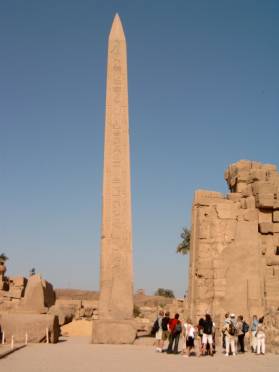
Past the giant columns stood the tallest obelisk existing in Egypt at
almost 30m high. Although made out of one piece of granite, the Obelisk
of Hatshepsut looks like it's made of two different stones as the lower
half was covered up for many years by Tuthmosis III in his resentment
towards his stepmother's usurpment of the throne. There once existed
17 obelisks but these now lie in various parts of the world.
The further we walked into the temple,
the older the temple and the more ruined it became so when we reached
the other side, it was a mass of ruins. |
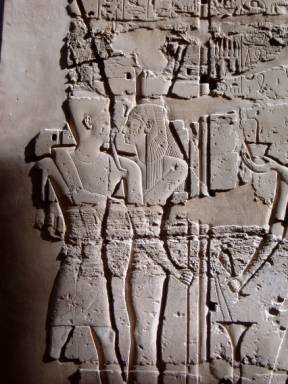
The most beautiful aspect of the temple to me were the images of a queen
embracing her pharaoh.
It was considered taboo for such displays
of close affection that for many years it was covered up with a gold
plate.
Near the Sacred Lake - a body of water used for priests' ablutions -
stood a giant scarab beetle. Adam told us to walk around it seven time
and our wishes would be granted. It would've been very comical to see
a large group of people all walking around this large beetle.
After 1½hr, it was time to move
on... to another commission-based stop - a cotton t-shirt shop with
template-printed t-shirts costing five times more than what I bought
them for. |
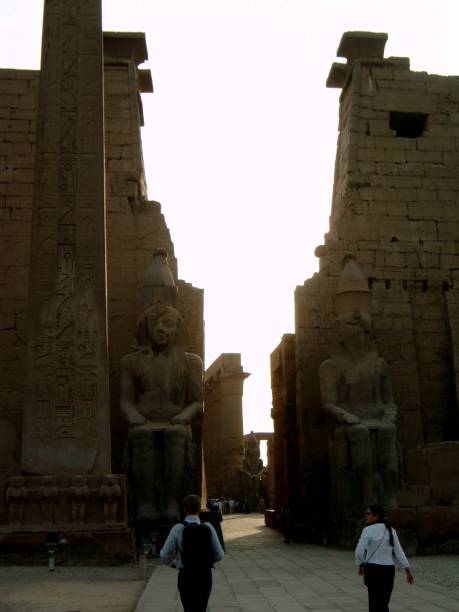
Finally our last tour - the Temple of Luxor==>
There was once an Avenue of Sphinxes that
joined the Temple of Karnak to the Temple of Luxor for 2.5km.
In pharaonic times, Luxor Temple sat at
the heart of the ancient capital of Thebes and was well-preserved because
it was once buried under the village of Luxor and even had a 13th-century
mosque built amongst its walls - which the villagers demanded it remain
during excavations of the site.
It is a temple that doesn't seem to be
flooded with tourists and at the diminishing lights of sunset, the temple
casts an eerie but beautiful shadow through the city. |
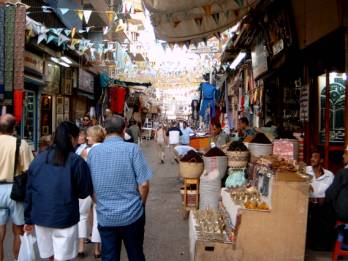 After
the tour, the rest of the family returned to the ship whilst our little
family decided to walk through the city - a short walk along the Nile.
Like the walk around Esna, we were interested in walking through the
streets, taking photos and seeing how people
lived - old men smoking bongs, tailors mending clothes, a man cleaning
cups in small coffeeshop, an open butcher with carcasses hanging by
the roadside, little kids all vying for a shot on a photo, women clad
from head to toe in black, children happily waving from all corners
- these people were smiled more and seemed friendlier - and none asking
for baksheesh (tip), and a sharp contrast to the streets of Esna. We
stopped for a drink on the rooftop of a hotel
and watched another fantastic sunset over
Luxor. After
the tour, the rest of the family returned to the ship whilst our little
family decided to walk through the city - a short walk along the Nile.
Like the walk around Esna, we were interested in walking through the
streets, taking photos and seeing how people
lived - old men smoking bongs, tailors mending clothes, a man cleaning
cups in small coffeeshop, an open butcher with carcasses hanging by
the roadside, little kids all vying for a shot on a photo, women clad
from head to toe in black, children happily waving from all corners
- these people were smiled more and seemed friendlier - and none asking
for baksheesh (tip), and a sharp contrast to the streets of Esna. We
stopped for a drink on the rooftop of a hotel
and watched another fantastic sunset over
Luxor.
|
|
|
|
|
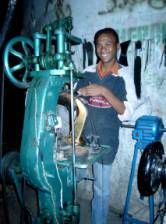 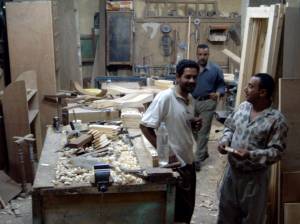 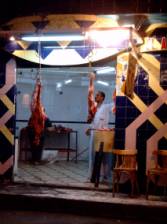
|
 After
our last dinner, we were entertained by a young boring bellydancer and
what I've been waiting to see... a Whirling Dervish - a display of Sufi
dancing. After
our last dinner, we were entertained by a young boring bellydancer and
what I've been waiting to see... a Whirling Dervish - a display of Sufi
dancing.
Sufism a semi-mystical branch of Islam
with an unorthodox approach to prayer ie dancing to attain a trancelike
union with God.
Urged on by the pulse of drums, strings
and pipes, the dancer spun in a blur of multicoloured skirts - reds,
yellows blue until he looked like a spinning top.
Photo Courtesy of Tour
Egypt Photos
|
Saturday 20 November 2004 (4:45am start)
Most of the family enjoyed the cruise and
the sights they saw. They were not very happy with the organisation
of the tour, with ridiculous early-morning starts, packed days on some
and almost nothing on others. Most of all, many of the family were unhappy
with Adam - we vented on our questionnaires and Ulla gave the AB Travel
Agent representative an earful, about how rude Adam had been, how unintelligible
his heavily-accented danish had been, he picked on some of us, glared
at the children for chattering at the back of the bus, he avoided questions
and scolded anyone who interrupted him with a question. Worst of all
were all these unneccesary "commission-based" trips that cut
into our sightseeing time. He was the typical Egyptian that could've
made our trip much more enjoyable.
From an early flight to Cairo, a mad-scramble
for our baggage, a three-hour wait in the coffeeshop of a nearby hotel
to a 4½hr flight back to København, it was 5pm by the
time we all retrieved our luggage and bade our final farewells to each
member of the family. Despite a 4:45am start, it took us a whole day
to return home.
There is a certain amount of sadness that
it may be last time the family is united as Bedstemor is getting on
in her years. René has been on approx ten reunions, organised
by Bedstemor's children but paid for the grandparents - as a legacy
to the family. I have been lucky and privileged to be invited to one
of these family gatherings - four generations in all. It allowed me
to visit another exotic part of the world and to get to know this very
special Matriach. |
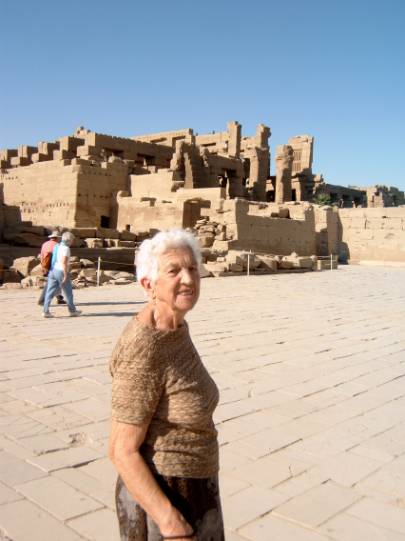
§ The End § |
|